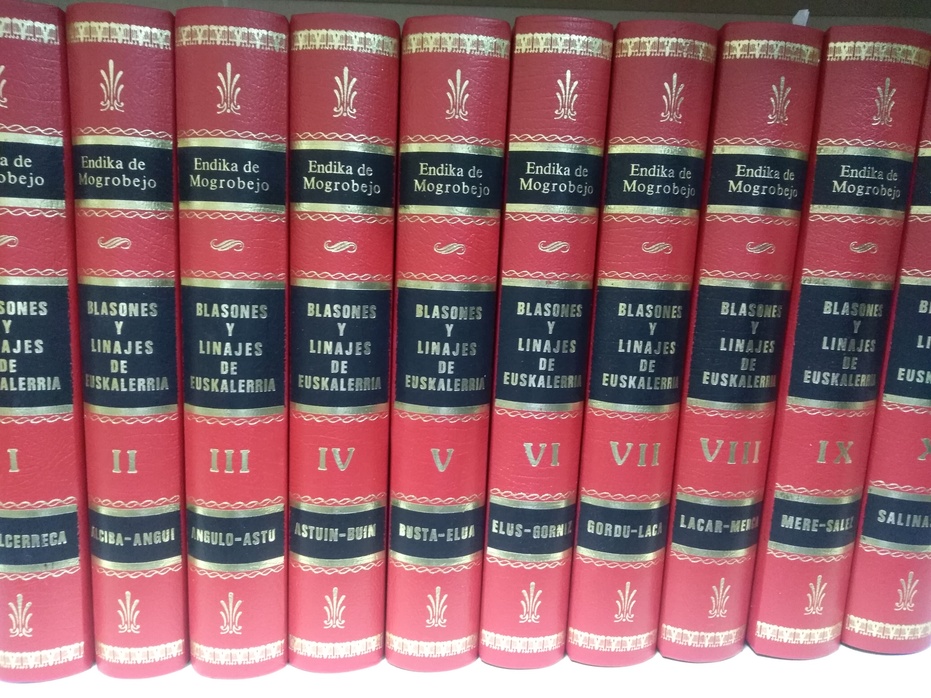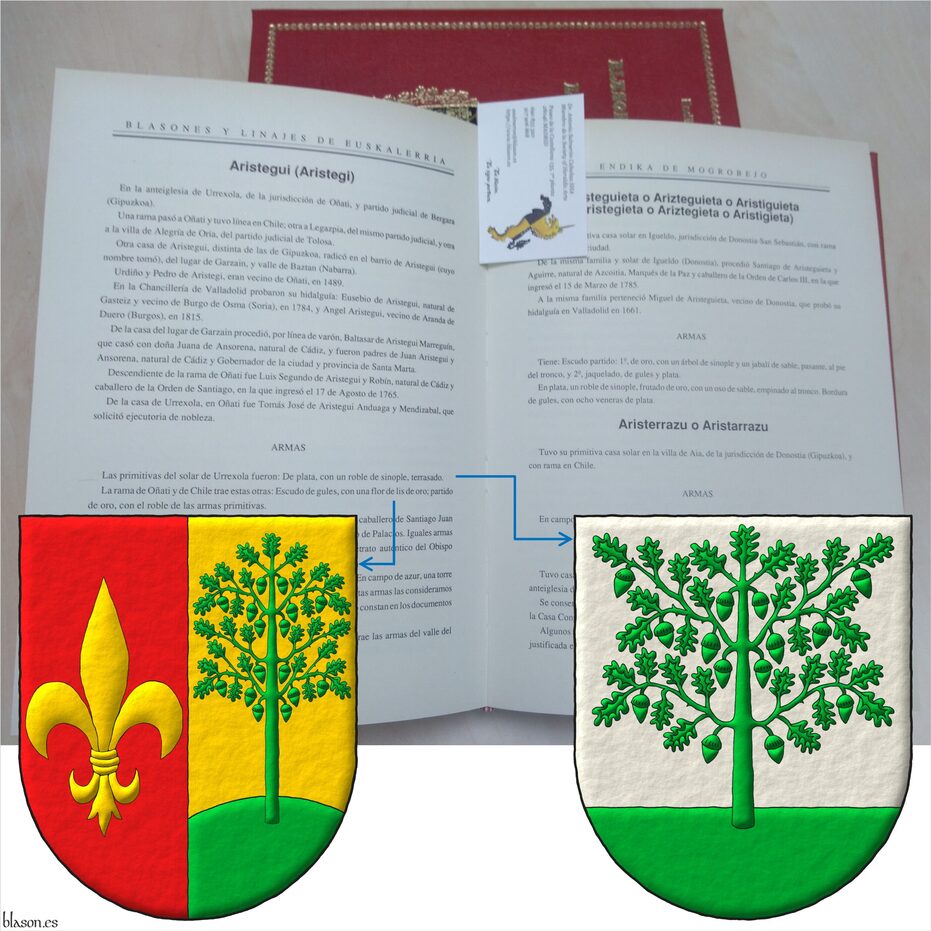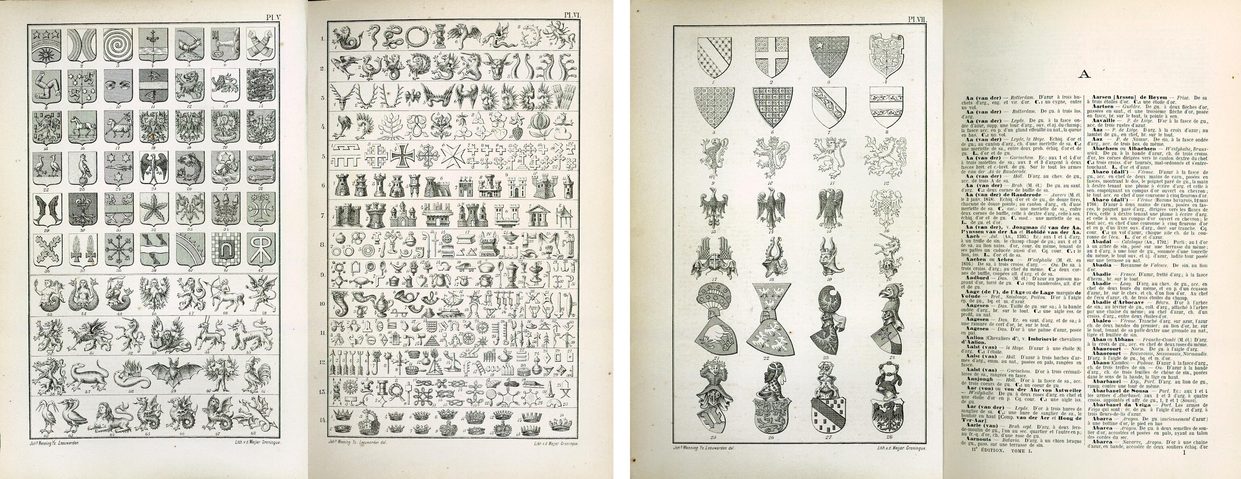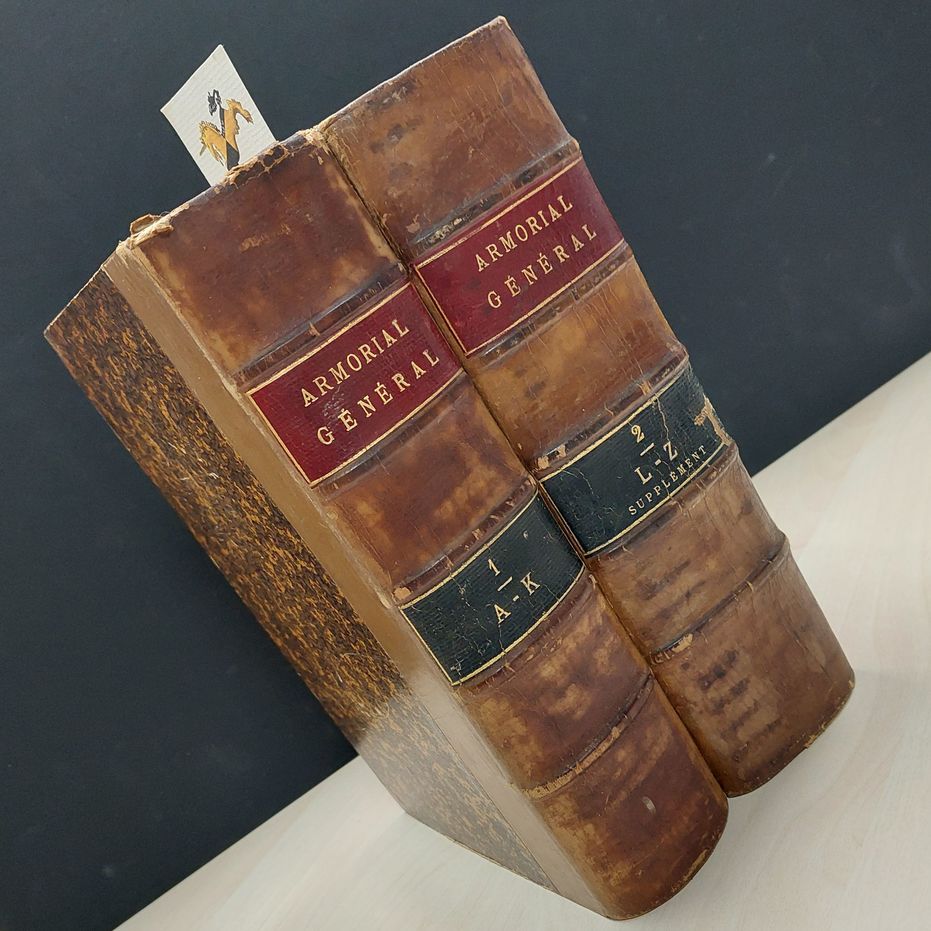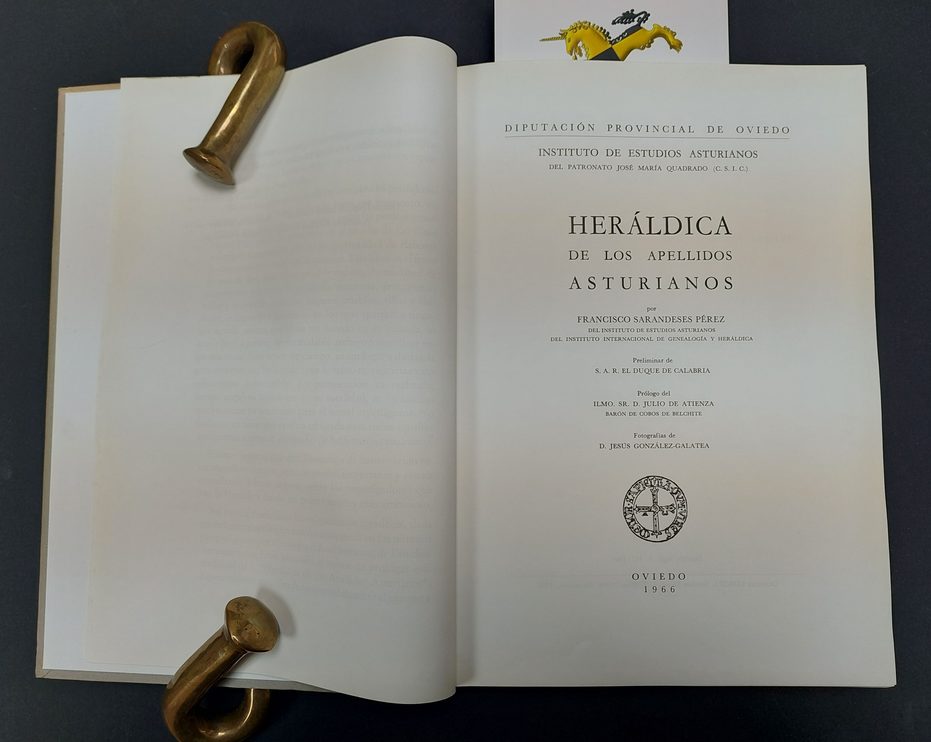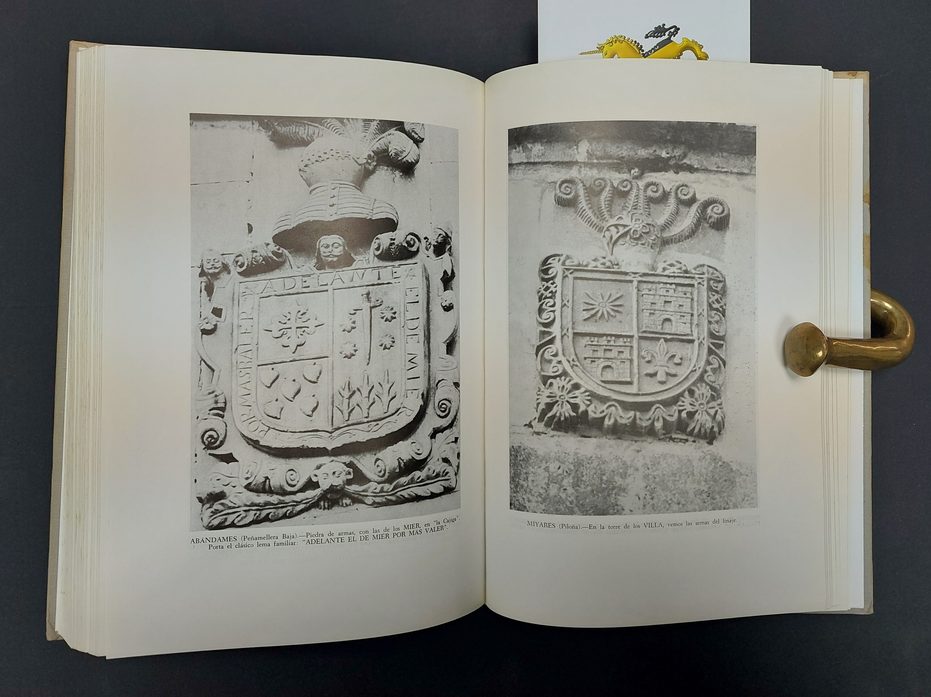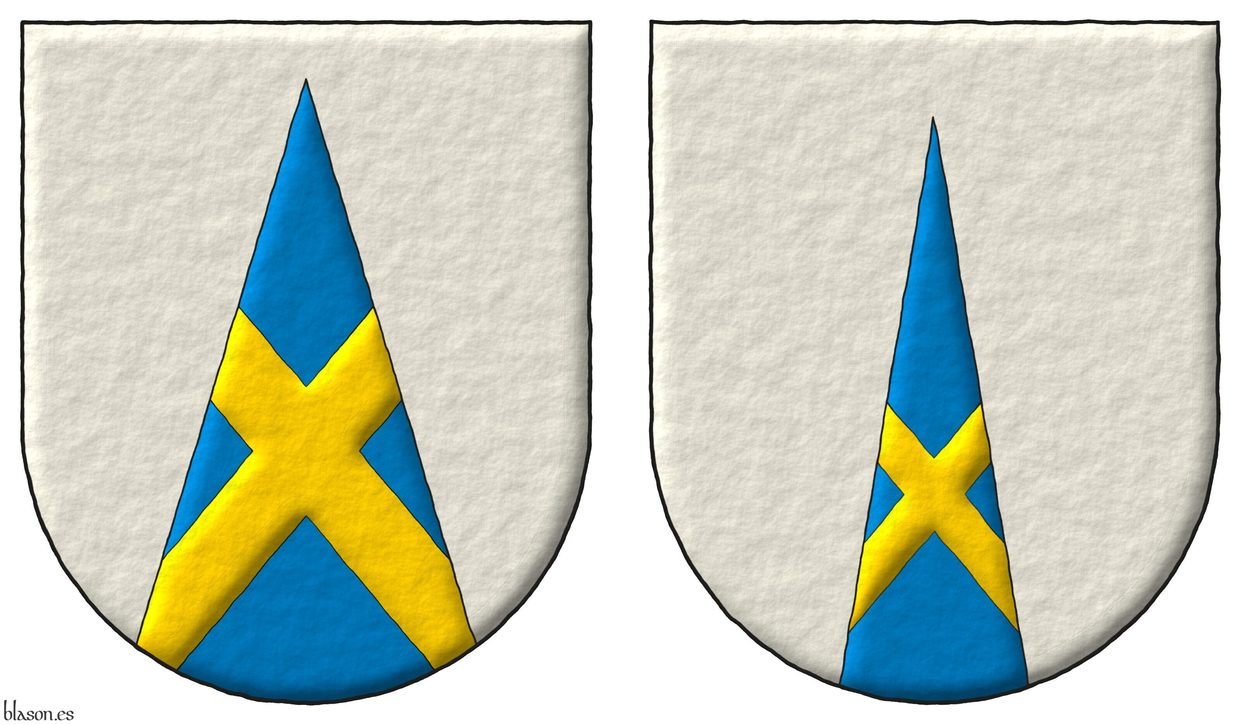Lineage

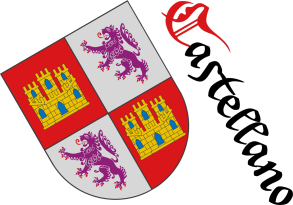
Albero, lineage of Aragon
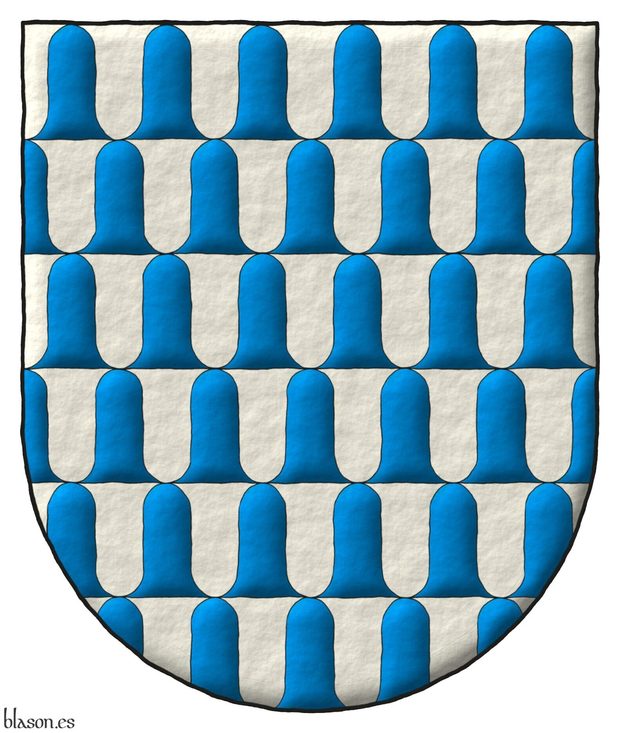
Blazon of the Albero lineage of Aragon.
Vair ancient.
Escudo de veros antiguos.
Illuminated and with a glass finish.
It can be consulted in [Cadenas y Vicent, V. de; 1987; page 62].
[Friar, S.; 1987; pages 157-158] says of the veros: «originates from the fur of a species of squirrel... which was popular in the Middle Ages as a lining for the garments of those not entitled to wear ermine. The animal was blue-grey on the back and white underneath. By sewing a number of these pelts together, with white and blue-grey alternating,... one which easily translated into the stylized armorial form of Vair and its variants».
Blazon keywords: Vair ancient.
Style keywords: Freehand, Outlined in sable, Illuminated and Semi-circular.
Classification: Interpreted, Lineage and Coat of arms.


Albrecht Dürer
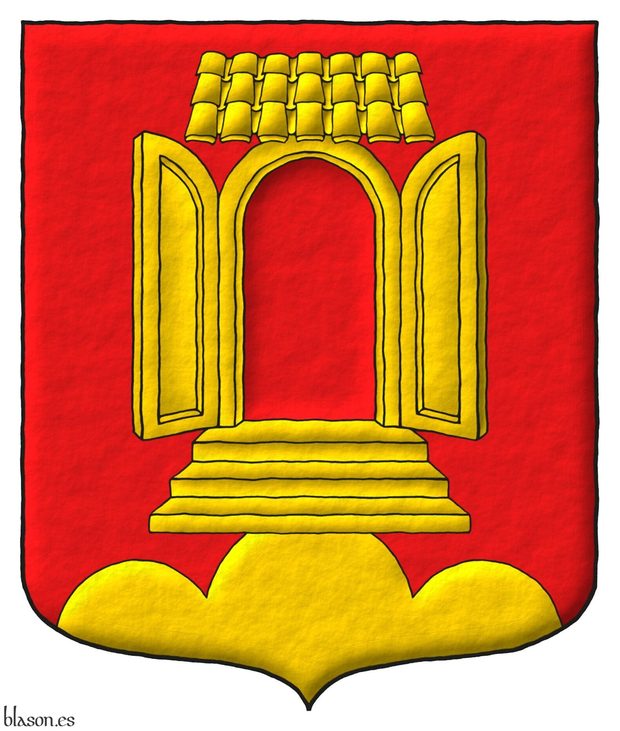
Gules, on a trimount issuant from the base Or, a port Gules, with canopy roof, jambs, enarched lintel, and two open leaves, upon a three-step stairway Oro.
Escudo de gules, un monte de tres peñas moviente de la punta sumado de una puerta con tejadillo, jambas, dintel arqueado, dos hojas abiertas sostenida de una escalinata de tres peldaños todo de oro, aclarada de gules.
Coat of arms painted by me, illuminated with lights and shadows, outlined in Sable, with an ogee external shape and with a freehand finish.
Coat of arms of Albrecht Dürer, 1471-1528, emblazoned by me based on the woodcut titled «Coat of Arms of Albrecht Dürer» made by Albrecht Dürer himself in 1523 on a sheet measuring 35.1 × 26.1 cm belonging to The Elisha Whittelsey Collection, The Elisha Whittelsey Fund, 1952, held at the Metropolitan Museum of New York, and on the work titled «Marriage Coat of Arms of the Families Duerer and Holper. Verso of the Albrecht Dürer the Elder portrait», dated 1490; Albrecht Dürer the Elder, 1427–1502, was his father.
Design rationale
The Dürer family coat of arms is an example of canting arms. Their family origin traces back to Ajtós, Hungary, a name which means «door» or «doorman» in Hungarian. Upon settling in Nuremberg, the family Germanized their surname to «Türer», derived from «Tür», meaning «door», and later to Dürer. This is the reason of the main charge of these arms.
Blazon keywords: Gules, One, Two, Three, On, Trimount, Issuant from base, Port, Canopy roof, Arched, Enarched, Upon, Step, Stairway and Port and windows.
Style keywords: Outlined in sable, Illuminated, Ogee and Freehand.
Classification: Personal, Lineage, Interpreted, Boa and Coat of arms.
Bearer: Albrecht Dürer.


Aldam, lineage of England
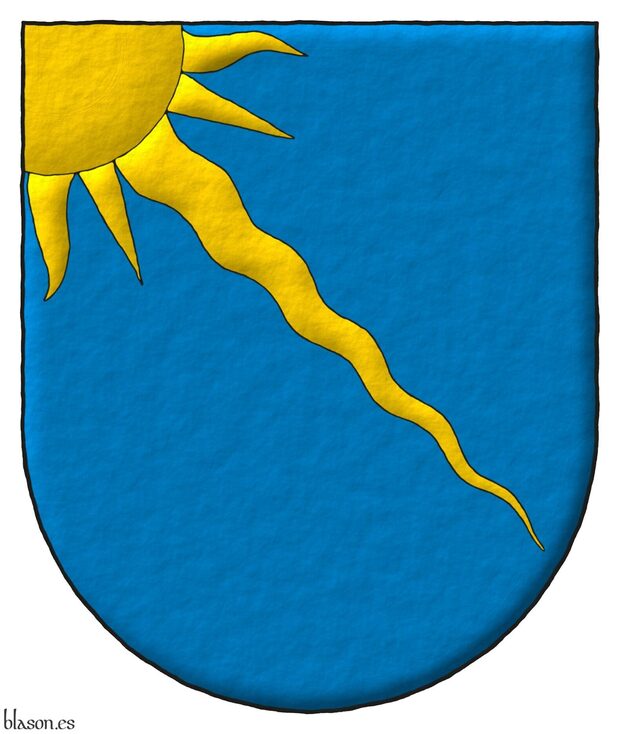
Blazon of the Aldam lineage of England.
Azure, a ray of the sun bendwise, issuant from the dexter chief Or.
Escudo de azur, un rayo de sol puesto en banda, naciente de la diestra del jefe de oro.
Illuminated with lights and shadows and with a freehand finish.
Described in [Burke, B.; 1989; page 9, column 1, entry 11].
Blazon keywords: Without divisions, Azure, One, Ray of the sun, Bendwise, Nascent, Dexter, Chief and Or.
Style keywords: Freehand, Outlined in sable, Illuminated and Semi-circular.
Classification: Interpreted, Lineage and Kingdom of England.


Alpoim, lineage

Azure, a crescent reversed Argent, in dexter chief a fleur de lis Or, a bordure Gules.
Escudo de azur, un creciente ranversado de plata, en la diestra del jefe una flor de lis de oro, una bordura de gules.
Arms emblazoned by me, highlighted with lights and shadows, contoured in Sable, with an ogee external shape and with a freehand finishing.
Coat of arms of the lineage Alpoim. This coat of arms has been created for Fernando Durán Cabral de Mello d’Alpoim as a preparatory work for his armorial bearings where the arms of Alpoim are in the 2nd quarter.
Blazon keywords: Azure, Argent, Or, Gules, One, Crescent, Reversed, In the dexter chief, Fleur de lis and Bordure.
Style keywords: Outlined in sable, Illuminated, Ogee and Freehand.
Classification: Personal, Lineage, Interpreted, Boa and Coat of arms.
Bearer: Alpoim, lineage.


Amancier, lineage of Genevois
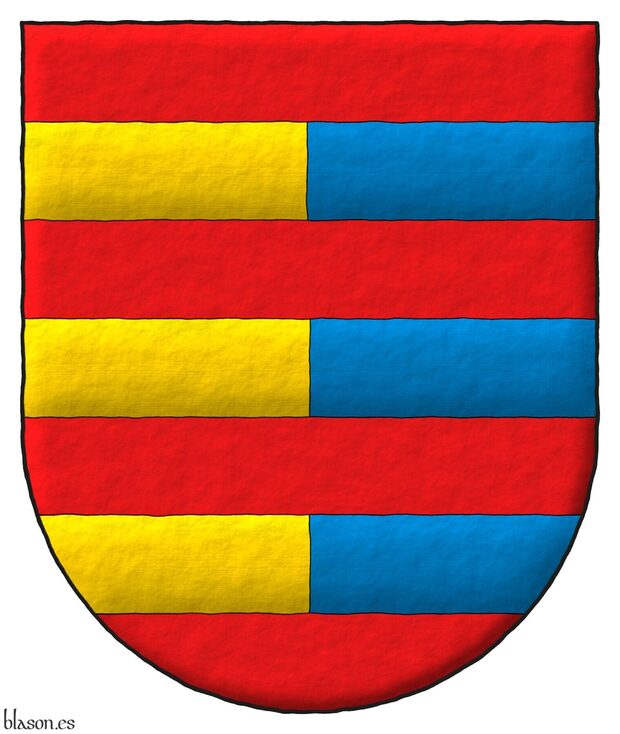
Blazon of the Amancier lineage of Genevois, Haute-Savoie, France.
Gules, three bars per pale Or and Azure.
Illuminated and a freehand finishing.
Its French blazon «de gueules, à trois fasces parties d'or et d'azur» can be found at [Rietstap, J. B.; 1861; page 40].
Any fess party per pale of metal and color or color and metal will always have a metal on metal or color on color conflict whether the field of the coat of arms is color or metal. There isn't conflict if the field of the coat of arms is also party per pale with metal under the color of the fess and with color under the metal of the fess or if the field is fur.
Blazon keywords: Without divisions, Gules, Three, Fess, Party per pale, Or and Azure.
Style keywords: Freehand, Outlined in sable, Illuminated and Semi-circular.
Classification: Interpreted, Lineage and Kingdom of France.


André, lineage of France
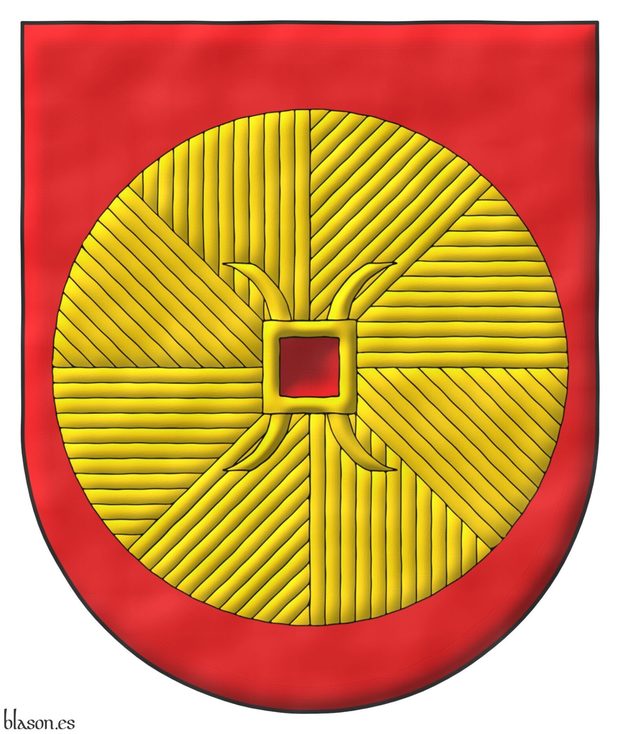
Blazon of the André lineage of France.
Gules, a millstone Or.
Escudo de gules, una piedra de molino de oro.
Illuminated and a watercolor finishing with shadow in the hole.
For its better identification, I have painted the millstone with the ring that fixes it to its axis. This ring is called a millrind, it is made of iron, and usually has 4 arms to better fix the millstone. Millrinds may appear on coats of arms independently of millstones. Another heraldic element related to the previous ones is the millwheel, which is a toothed gear that is part of the mill mechanism but should not be confused with the millstone that grinds the grain.
Blazon keywords: Without divisions, Gules, One, Millstone and Or.
Style keywords: Watercolor, Outlined in sable, Illuminated and Semi-circular.
Classification: Interpreted, Lineage and Kingdom of France.


![Ver [Anonymous; 1800a] en referencias bibliográficas. Libro abierto, hojas de plata, filo de oro, guardas de gules, tapas de sable.](../css/Libro.Bibliografia.png)
Anonymous; 1800a
Anonymous, «Armerías de España», 124 double pages, title in the page 9, provenance Duke of Osuna and Infantado, 1800.
Content
The book has no index and its content, written by hand, is as follows:
- Pages 1 through 8 are blank.
- On page 9, title, the letter A begins and surnames Abarca, Abendaño, Abeo, Ablitas and Abrego in large handwritten and the blazon in small handwritten (except for the end of the book on page 123, the unknown author seems to write more about surnames than about lineages).
- On page 10, the surnames with the letter A continue and their blazon both in small handwritten.
- On page 23, the letter B begins, its surnames and their blazons, for example, the Barrasas, in the page 25, «Or, six Lions proper, combatant».
- On page 30, the letter C begins, it is followed by the letter Z on page 42, 29 surnames with Z was written before the letter D and Cocas and Cuacas, with the letter C, are inserted inside the letter Z.
- It follows in alphabetical order of surnames from page 46, where the letter D begins, to page 97 with the letter S, including in the S the surname Sánchez on page 99, as a lineage will be included at the end of the book, and it follows with the letter S until the page 104.
- On page 105 the letter T begins, surname Tabixas, Taboadas, Tafuxes, ...
- On page 109 jump from the letter T to the letter V, with the surnames Vacas, Vadillos,... and skipping the letter U.
- On page 119, it returns from letter V to U, in an unordered manner and without including the title with the capital letter U.
- On page 120, begins the letter X and also the letter Y.
- On page 122, the letter Z and only 3 additional surnames with Z, recall that the majority of the surnames with Z were included after the letter C.
- On page 123 he returns to the surname Sánchez by testimony of Pedro de Soto owner of the books of Armory of Spain of Andreas Heredia, King of Arms, and finally the unknown author copies the text for the surname Sánchez, those who were «hijosdalgos, en Cangas de Gobadonga» ~ Covadonga of Asturias and ends with a poem of 8 verses. Andreas Heredia, also known as Andrés Heredia, was King of Arms during the reign of Philip III of Spain, [Nieto y Cortadellas, R.; 1957a; Page 4]
- Beginning on page 124 are blank.
Bibliographical reference of century XVIII.
Classification: Manuscript, Armorial roll, In black and white and Castilian language.
Author: unknown.
Bibliographical reference mentioned in the following article:
External links:
- Detail of this Armorial in the National Library of Spain.
- Bibliographic record of the National Library of Spain.
- Scanned Armorial in the National Library of Spain.
Internal resources: Osuna1800.ArmeriaEspaña.Manuscrito.pdf.


Araneta, lineage
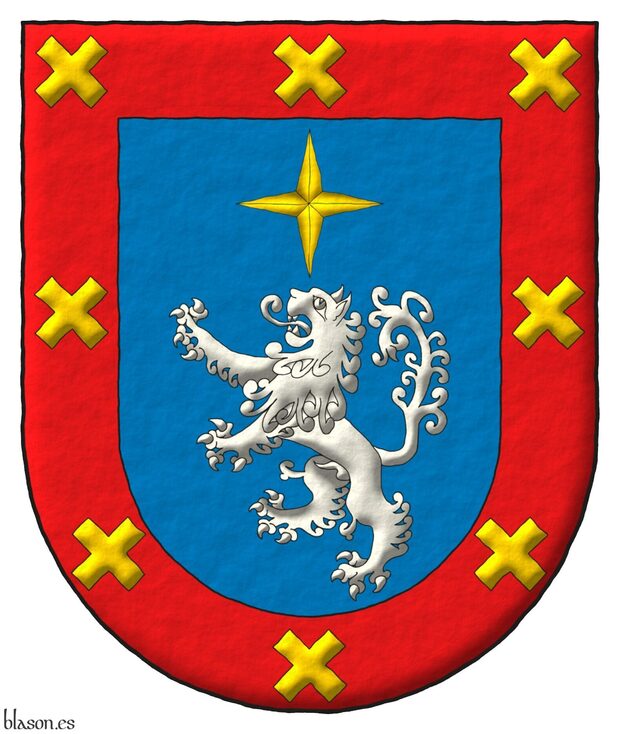
Azure, a lion rampant Argent, in chief a mullet of four points Or; a bordure Gules charged with eight saltires couped Or.
Escudo de azur, un león rampante de plata, surmontado de un lucero de oro; una bordura de gules cargada de ocho sotueres de oro.
Coat of arms emblazoned by me, highlighted with lights and shadows, contoured in Sable, with a semi-circular outer contour and with a freehand finishing.
These are the ancient arms of the lineage Araneta emblazoned by me. They are from the Basque Country and there is a branch in the Philippines. This star is known as mullet of four points.
Blazon keywords: Azure, Argent, Or, Gules, One, Eight, Lion, Rampant, Mullet of four points, Bordure, Saltire and Couped.
Style keywords: Outlined in sable, Illuminated, Semi-circular and Freehand.
Classification: Personal, Lineage, Interpreted, Boa and Coat of arms.
Bearer: Araneta, lineage.


![Ver [Argote de Molina, G.; 1588] en referencias bibliográficas. Libro abierto, hojas de plata, filo de oro, guardas de gules, tapas de sable.](../css/Libro.Bibliografia.png)
Argote de Molina, G.; 1588
Gonzalo Argote de Molina, «Nobleza de Andalucía», dedicated to King Philip II of Spain, with about 500 coat of arms engraved, printed by Fernando Díaz, Seville, 1588.
There are other editions, for example, the edition by Francisco López Vizcaíno, 799 pages, Jaen, 1867, or facsimile edition by Riquelme y Vargas Ediciones SL, Jaén, 1991, my copy is the number 1268.
Bibliographical reference of century XVI.
Classification: De bibliotheca, Castilian language and In black and white.
The author is Argote de Molina, Gonzalo.
The following articles cite this bibliographic reference:
- Alfonso IX of Leon
- Alfonso VIII of Castile
- Argote de Molina, Gonzalo
- James I of Aragon
- Álvaro de Zúñiga y Guzmán
External links:
- Virtual Library of Andalusia, 1867.
- Digital Library Madrid's memory, 1588 edition from page 6 missing cover and initial pages.
- National Library of Spain, bibliographic record, there are 2 copies of the edición of 1588.
- National Library of Spain, edition of 1588, cover of the first copy.
- National Library of Spain, edition of 1588, cover of the second copy, this has more resolution than the previous copy.
- Google Books, the second book and not complete.
Internal resources: ArgoteMolinaG1588.22.NoblezaAndalucia.Madrid.pdf is the edition of the year 1588 in PDF digital format, ArgoteMolinaG1588.23.Bne.Baja.resolucion.R10805.pdf is the edition of the year 1588 in PDF digital format and low resolution, ArgoteMolinaG1588.24.Bne.Alta.resolucion.R26842.pdf is the edition of the year 1588 in PDF digital format and hight resolution, ArgoteMolinaG1588.25.NoblezaAndalucia.1867.pdf is the edition of the year 1866 in PDF digital format for Adobe Reader only and a facsimile edition as a physical book on paper.


Argudo of Guipuzcoa, lineage
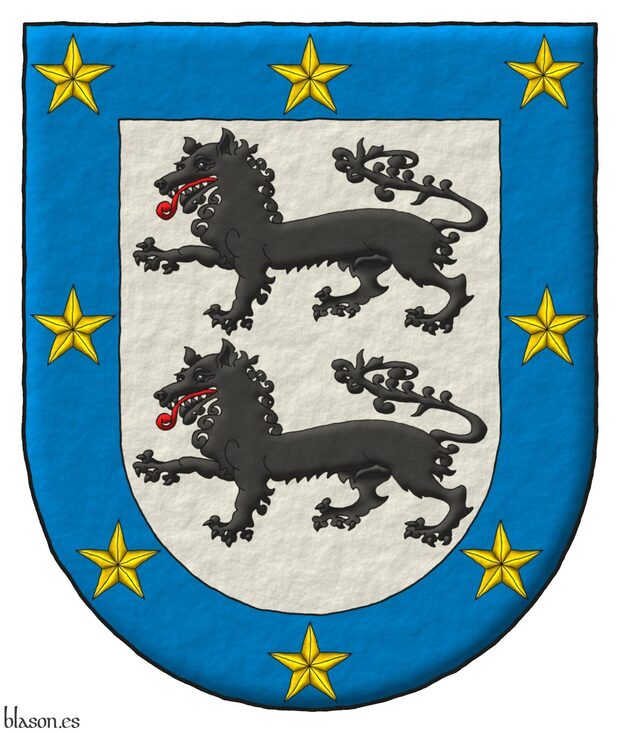
Argent, two wolves passant, in pale Sable, langued Gules; a bordure Azure charged with eight mullets Or.
Escudo de plata, dos lobos pasantes, en palo de sable, lampasados de gules; una bordura de azur cargada de ocho estrellas de oro.
Arms depicted by me, illuminated with lights and shadows, outlined in Sable, with a semi-circular outer contour and with a freehand finishing.
Ancient arms of the lineage Argudo of Guipuzcoa emblazoned by me. The lineage Ochoa of Vergara has a blazon equivalent to this one. Alternative blazon: «Argent, two wolves passant, in pale Sable, langued Gules; on a bordure Azure, eight mullets Or».
Blazon keywords: Argent, Sable, Gules, Azure, Or, One, Eight, Wolf, Passant, In pale, Bordure and Mullet.
Style keywords: Outlined in sable, Illuminated, Semi-circular and Freehand.
Classification: Personal, Lineage, Interpreted, Boa and Coat of arms.
Bearer: Argudo of Guipuzcoa, lineage.


Avelar, lineage of Portugal
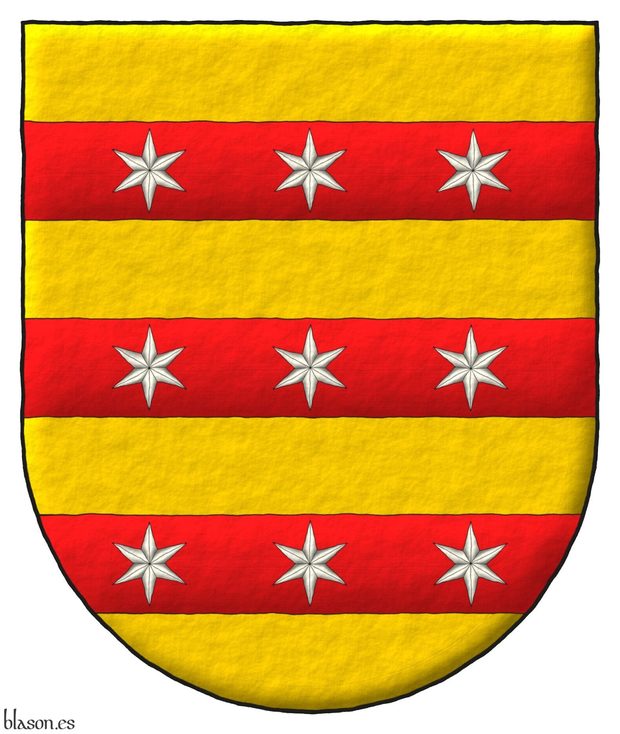
Blazon of the Avelar lineage of Portugal.
Or, three bars Gules charged each one with three mullets of six points Argent.
Illuminated and a freehand finishing.
It can be found at [Cró, J. do; 1509; page 127].
Blazon keywords: Without divisions, Or, Three, Fess, Gules, Charged, Mullet and Argent.
Style keywords: Freehand, Outlined in sable, Illuminated and Semi-circular.
Classification: Interpreted, Lineage and Kingdom of Portugal.


Baldovino from Venecia, lineage
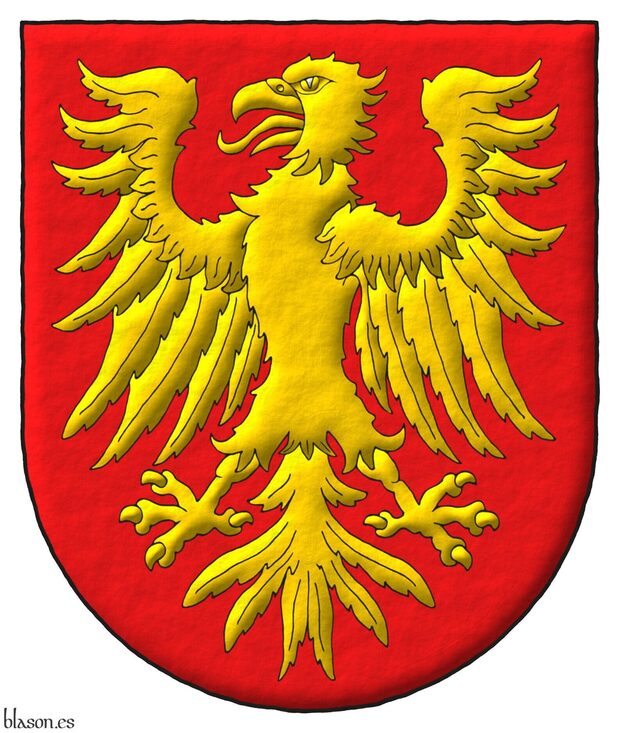
Gules, an eagle displayed Or.
Escudo de gules, un águila de oro.
Coat of arms interpreted by me, illuminated with lights and shadows, outlined in Sable, with a semi-circular outer contour and with a freehand finish.
Blazon keywords: Gules, Or, One, Eagle and Displayed.
Style keywords: Outlined in sable, Illuminated, Semi-circular and Freehand.
Classification: Personal, Lineage, Interpreted, Boa and Coat of arms.
Bearer: Baldovino from Venecia, lineage.


Bourgeois, lineage of Burgundy
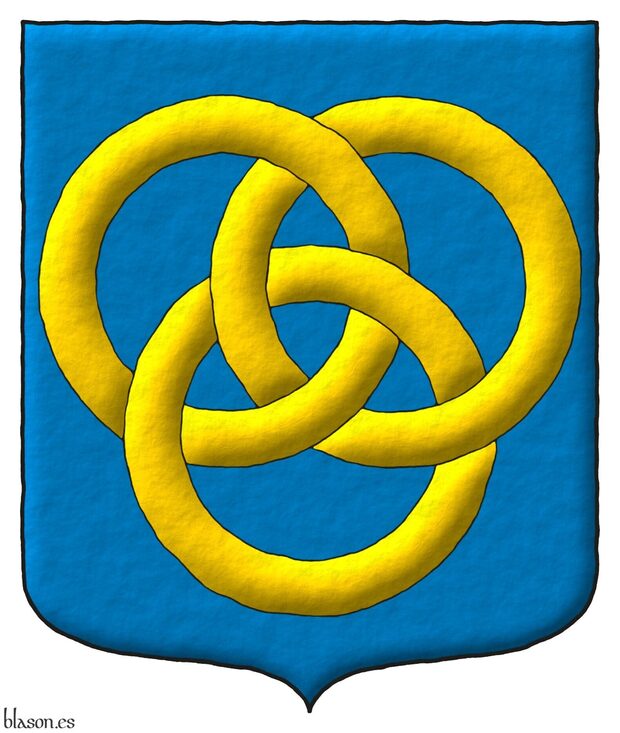
Azure, three annulets interlaced Or.
Illuminated, with a watercolor finishing and with a pointed shape.
You can found it at [Avilés, J.; 1725a; page 76 and illustration 177]], and at [Avilés, J.; 1780a; page 85 and illustration 177]].
Blazon keywords: Without divisions, Azure, Three, Annulet, Interlaced and Or.
Style keywords: Watercolor, Outlined in sable, Illuminated and Pointed.
Classification: Interpreted, Lineage, Kingdom of France and Coat of arms.


Bourgeois, lineage of Burgundy, France

Azure, three annulets interlaced Or.
Escudo de azur, tres anilletes entrelazados de oro.
Coat of arms emblazoned by me with plain color Azure and metal Or and with a shape ended with an ogee arch.
Blazon keywords: Without divisions, Azure, Three, Annulet, Interlaced and Or.
Style keywords: Watercolor, Outlined in sable, Illuminated and Ogee.
Classification: Interpreted, Lineage, Kingdom of France and Coat of arms.


Boyd of Scotland, lineage
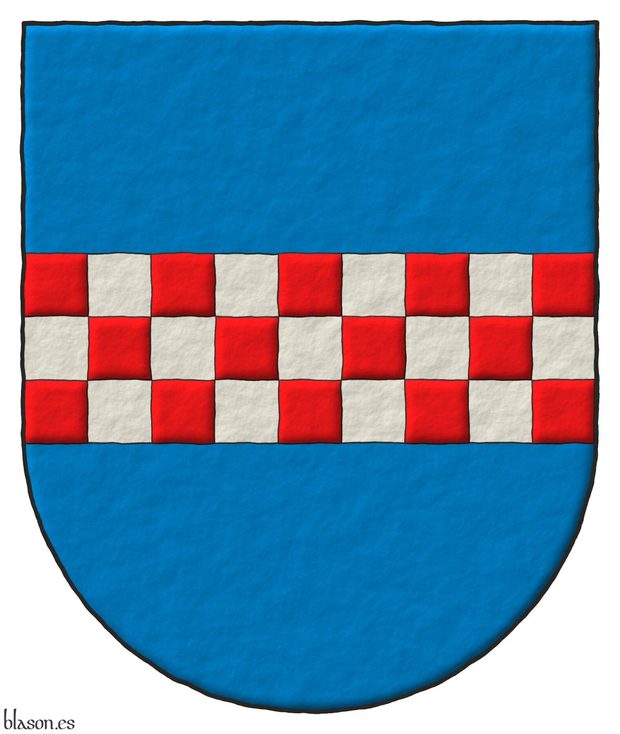
Azure, a fess chequey Gules and Argent.
Escudo de azur, una faja ajedrezada de gules y plata.
Coat of arms interpreted by me, highlighted with lights and shadows, contoured in Sable, with a semi-circular external shape and with a freehand finishing.
Coat of arms of the lineage Boyd of Scotland. I have emblazoned it with a fess chequy of 3 rows, symmetric and with 9 columns of squares, provided that its height is 1/3 of the width of the coat of arms.
Blazon keywords: Azure, Gules, Argent, One, Three, Nine, Fess and Chequey.
Style keywords: Outlined in sable, Illuminated, Semi-circular and Freehand.
Classification: Personal, Lineage, Interpreted, Boa and Coat of arms.
Bearer: Boyd of Scotland, lineage.


![Ver [Burke, B.; 1842] en referencias bibliográficas. Libro abierto, hojas de plata, filo de oro, guardas de gules, tapas de sable.](../css/Libro.Bibliografia.png)
Burke, B.; 1842
Sir Bernard Burke, C. B., LL. D., Ulster King of Arms, «The General Armory of England, Scotland, Ireland and Wales; Comprising a Registry of Armorial Bearings from the Earliest to the Present Time», Harrison, London, 1842.
Sir Bernard Burke, C. B., LL. D. (1814-1892), also cited as John Bernard Burke, was a British genealogist. He was son of the genealogist John Burke (1787–1848). In 1853, Sir Bernard Burke was appointed Ulster King of Arms.
I use to consult [Burke, B.; 1989] and [Burke, B.; 2009].
Bibliographical reference of century XIX.
Classification: In black and white and English language.
Author: Burke, Bernard.
The following articles cite this bibliographic reference:
External resource:


![Ver [Burke, B.; 1989] en referencias bibliográficas. Libro abierto, hojas de plata, filo de oro, guardas de gules, tapas de sable.](../css/Libro.Bibliografia.png)
Burke, B.; 1989
Sir Bernard Burke, C. B., LL. D., Ulster King of Arms, «The General Armory of England, Scotland, Ireland and Wales; Comprising a Registry of Armorial Bearings from the Earliest to the Present Time», edited by Heraldry Today, printed by Redwoods Books, 1185 pages and an initial supplement with 130 pages, Trowbridge, Wiltshire, 1989.
Its first edition was [Burke, B.; 1842].
Bibliographical reference of century XX.
Classification: De bibliotheca, In black and white and English language.
Author: Burke, Bernard.
The following articles cite this bibliographic reference:
Internal resources: Paper edition.


![Ver [Burke, B.; 2009] en referencias bibliográficas. Libro abierto, hojas de plata, filo de oro, guardas de gules, tapas de sable.](../css/Libro.Bibliografia.png)
Burke, B.; 2009
Sir Bernard Burke, C. B., LL. D., Ulster King of Arms, «The General Armory of England, Scotland, Ireland and Wales; Comprising a Registry of Armorial Bearings from the Earliest to the Present Time», Heritage Books, 496 pages, Berwyn Heights, Maryland, 2009.
In [Burke, B.; 1842] all editions of this book can be consulted.
Bibliographical reference of century XXI.
Classification: In black and white and English language.
The author is Burke, Bernard.
Bibliographic reference mentioned in the following articles:
External link:


Burr, lineage
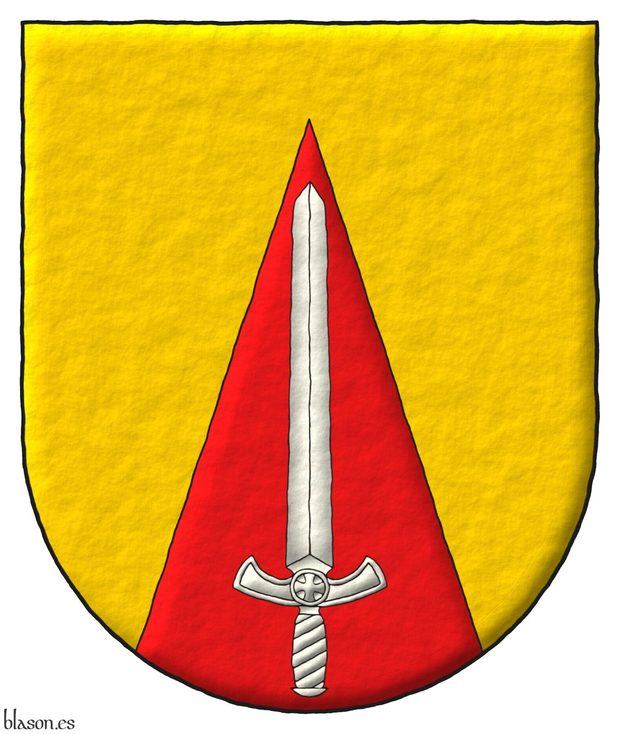
Or, on a pile issuant from the base Gules a sword point upwards Argent.
Escudo de oro, una pira de gules cargada de una espada alzada de plata.
Arms emblazoned by me, highlighted with lights and shadows, outlined in Sable, with a semi-circular outer contour and with a freehand finishing.
Coat of arms of the lineage Burr emblazoned by me based on the description by [Cadenas y Vicent, V. de; 1987; page 388].
Blazon keywords: Or, Gules, Argent, One, Pile issuant from base, Charged, Sword and Point upwards.
Style keywords: Outlined in sable, Illuminated, Semi-circular and Freehand.
Classification: Personal, Lineage, Interpreted, Boa and Coat of arms.
Bearer: Burr, lineage.


Cabral, lineage
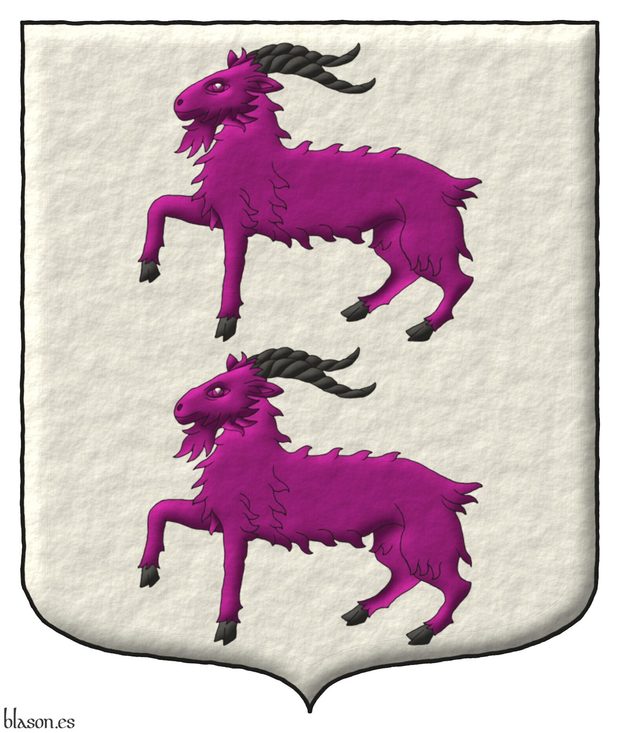
Argent, two goats in pale Purpure, horned Sable.
Escudo de plata, dos cabras en palo de púrpura, acornadas de sable.
Coat of arms depicted by me, highlighted with lights and shadows, contoured in Sable, with an ogee outer contour and with a freehand finishing.
Coat of arms of the lineage Cabral. This coat of arms has been created for Fernando Durán Cabral de Mello d’Alpoim as a preparatory work for his armorial bearings where the arms of Cabral are in the 3rd quarter.
Blazon keywords: Argent, Purpure, Sable, Two, Goat, In pale and Horned.
Style keywords: Outlined in sable, Illuminated, Ogee and Freehand.
Classification: Personal, Lineage, Interpreted, Boa and Coat of arms.
Bearer: Cabral, lineage.


Carlos Vidriales, certification, pages 6 and 7
Arms of Carlos Vidriales García Bustamante painted by me in the Certification of the King of Arms of Castile and Leon Alfonso de Ceballos-Escalera and Gila, Marquess of La Floresta, Viscount of Ayala and grand of Spain. The image shows the pages 6 and 7 of this certification.
Credits:
- Alfonso de Ceballos-Escalera y Gila is the author of the certification of arms.
- Antonio Salmerón y Cabañas is the author of the heraldic art for the certified coat of arms.
Categories: Certification, Heraldic document, Coat of arms, Interpreted, Personal, Semi-circular, Illuminated, Outlined in sable, Party per pale, Argent, Cross, Sable, Bordure, Motto, Or, Thirteen, Hurt, Hurt, torteau, pellet, pomme and golpe, Azure, Three, In pale, Four, Five, Chief, Fleur de lis, Lineage, Conjoined in fess, Decoration, Suspended and Base (lower 1/3).
Root: Vidriales García y Bustamante, Carlos.


![Ver [Chaparro D'Acosta L.; 1979] en referencias bibliográficas. Libro abierto, hojas de plata, filo de oro, guardas de gules, tapas de sable.](../css/Libro.Bibliografia.png)
Chaparro D'Acosta L.; 1979
Lino Chaparro D'Acosta, «Heráldica de los Apellidos Canarios», foreword by Vicente de Cadenas y Vicent, 2 volumes, Volume I from A to L, 285 surnames, 293 pages, Volume II from M to Z and a heraldic dictionary, 387 surnames, 439 pages, edited by Estudios Tecnicos del Blason, ISBN of the complete work 84-300-2000-4, ISBN of Volume I 84-300-1989-8, ISBN of Volume I II 84-300-418010-8, Las Palmas de Gran Canaria, 1979.
Bibliographical reference of century XX.
Classification: Black and white with color plates and Castilian language.
The author is Chaparro D'Acosta, Lino.
The following article cites this bibliographic reference:


City of Haguenau, Alsace
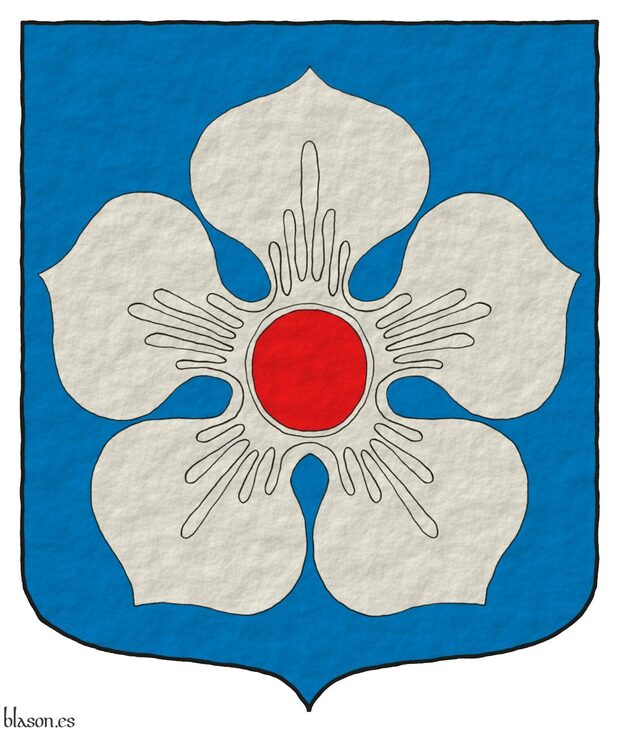
Azure, a cinquefoil Argent, seeded Gules.
Escudo de azur, un quinquefolio de plata, botonado de gules.
Coat of arms emblazoned by me with plain color Azure and metal Or and with a shape ended with an ogee arch.
Blazon keywords: Without divisions, Azure, One, Cinquefoil, Argent, Seeded and Gules.
Style keywords: Outlined in sable, Illuminated and Ogee.
Classification: Interpreted, Lineage, Kingdom of France, Civic and Coat of arms.
Bearer: Haguenau.


Durán, lineage
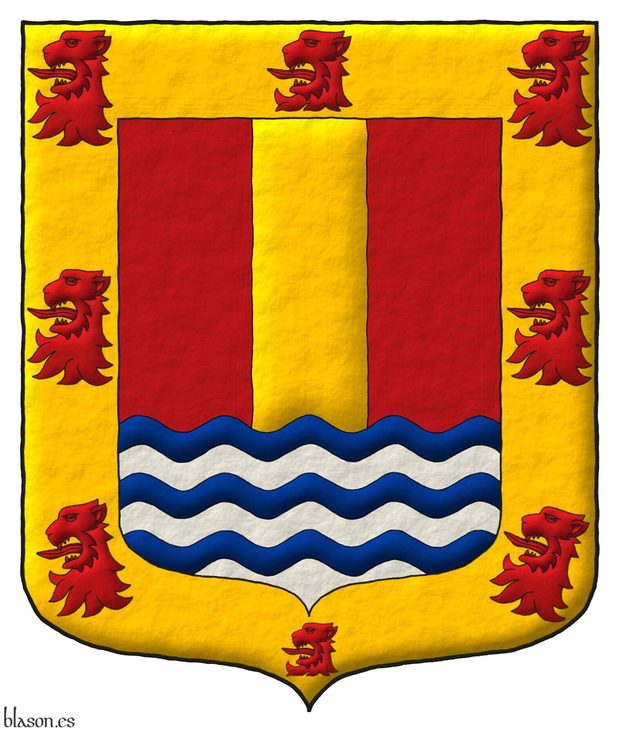
Gules, a pale Or upon six waves Azure and Argent, a bordure Or charged with eight lions' heads erased Gules.
Escudo de gules, un palo de oro sostenido de seis ondas de azur y plata, una bordura de oro cargada de ocho cabezas de león arrancadas de gules.
Coat of arms depicted by me, highlighted with lights and shadows, contoured in Sable, with an ogee external shape and with a freehand finish.
Coat of arms of the lineage Durán. This coat of arms has been created for Fernando Durán Cabral de Mello d’Alpoim as a preparatory work for his armorial bearings where the arms of Durán are in the 1st quarter.
Blazon keywords: Gules, Or, Azure, Argent, One, Six, Eight, Pale, Upon, Wave, Bordure, Charged, Lion, Head and Erased.
Style keywords: Outlined in sable, Illuminated, Ogee and Freehand.
Classification: Personal, Lineage, Interpreted, Boa and Coat of arms.
Bearer: Durán, lineage.


Duran, lineage of Andalucia, Extremadura, and Aragon
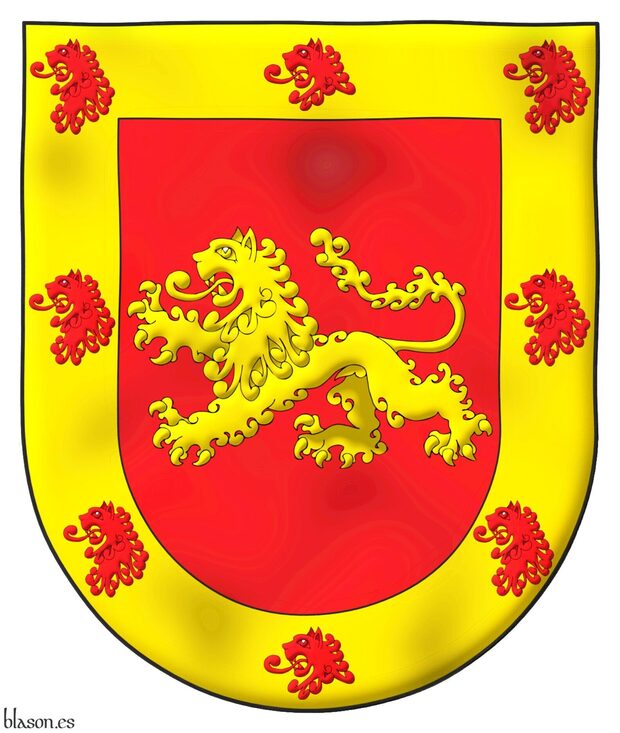
Blazon of the Duran lineage of Andalucia, Extremadura, and Aragon.
Gules, a lion passant Or; a bordure Or charged with eight lions’ heads erased Gules.
Escudo de gules, un león leopardado de oro; una bordura de oro, cargada de ocho cabezas de león arrancadas de gules.
Illuminated and with a glass finish.
Blazon keywords: Gules, Lion passant, Or, One, Bordure, Charged, Eight, Head and Erased.
Style keywords: Glass, Outlined in sable, Illuminated and Semi-circular.
Classification: Interpreted, Lineage and Coat of arms.


Egado, lineage
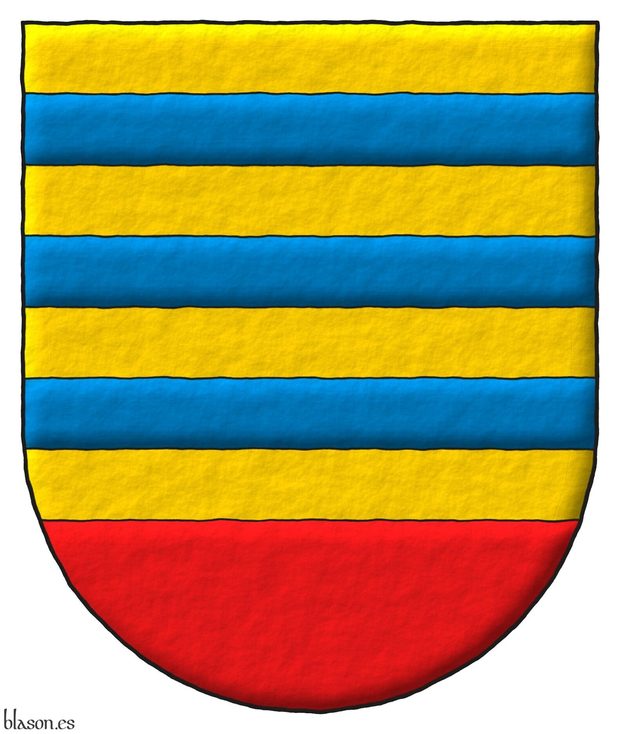
Or, three bars Azure; the base Gules.
Escudo de oro, tres burelas de azur; la punta de gules.
Arms painted by me, illuminated with lights and shadows, contoured in Sable, with a semi-circular outer contour and with a freehand finish.
Coat of arms of the lineage Egado emblazoned by me based on the description by [Cadenas y Vicent, V. de; 1987; page 635].
Blazon keywords: Or, Azure, Gules, Three, Bar and Base (lower 1/3).
Style keywords: Outlined in sable, Illuminated, Semi-circular and Freehand.
Classification: Personal, Lineage, Interpreted, Boa and Coat of arms.
Bearer: Egado, lineage.


Fernando Durán Cabral de Melo e Alpoim, scheme of 7 coats of arms
Quarterly: 1 Gules, a pale Or upon six waves Azure and Argent, a bordure Or charged with eight lions' heads erased Gules [for Durán]; 2 Azure, a crescent reversed Argent, in dexter chief a fleur de lis Or, a bordure Gules [for Alpoim]; 3 Argent, two goats in pale Purpure, horned Sable [for Cabral]; 4 Gules, a double cross throughout Or cantoned by six plates, a bordure Or [for Melo]; an inescutcheon quarterly: 1 and 4 Argent, five escutcheons in cross Azure, each charged with five plates in saltire; a bordure Gules, charged with seven castles triple-towered Or, 3, 2, and 2 [for Portugal]; the whole debruised by a baston Sable; 2 and 3 party per chevron Argent and Gules, in chief two lions combatant Purpure, armed and langued Gules [for Leon], in base a castle triple-towered Or, port and windows Azure, masoned Sable [for Castile]; a bordure compony of eighteen sections Or and vair [for Álvarez de las Asturias].
Scheme of the arms of Fernando Durán Cabral de Melo e Alpoim y Ayala-Schiaffino. These arms have been certified by Dr. Alfonso Ceballos-Escalera Gila, Chronicler of Arms of Castile and León. Both the scheme and the arms have been emblazoned by me. This illustration shows this coat of arms and, around it, the coats of arms that compose it, arranged radially so as to make their integration into the greater shield visible; these are the arms of the Durán, Alpoim, Cabral, and Melo lineages, together with the central inescutcheon, which is the coat of arms of the House of Noronha, which quarters Portugal differenced by a baston Sable and the House of Trastámara.
Blazon keywords: Gules, Or, Azure, Argent, One, Two, Six, Seven, Eight, Eighteen, Quarterly, Pale, Upon, Wave, Bordure, Charged, Lion, Head, Erased, Crescent, Reversed, In the dexter chief, Fleur de lis, Goat, In pale, Horned, Double cross throughout, Cantoned, Plate, Inescutcheon, Escutcheon, In cross, In saltire, Castle, Triple-towered, Cadency, Baston, Party per chevron, In chief, Combatant, Armed, Langued, In base, Port and windows, Masoned, Compony and Vair.
Style keywords: Outlined in sable, Illuminated and Ogee.
Classification: Personal, Lineage, Interpreted, Schema, Boa and Coat of arms.
Bearer: Durán Cabral de Melo e Alpoim, Fernando.


![Ver [Ferrer i Vives, F.; 1995] en referencias bibliográficas. Libro abierto, hojas de plata, filo de oro, guardas de gules, tapas de sable.](../css/Libro.Bibliografia.png)
Ferrer i Vives, F.; 1995
Francesc d'A Ferrer i Vives, «Heraldica Catalana», 3 volumes, Volume I A-F, Volume II G-P, Volume III Q-Z, ISBN of the complete work 84-7304-204-2, Legal Deposit B.20.464 - april 1995, Editorial Milla, Carrer de Sant Pau 21, Barcelona, 1995.
Bibliographical reference of century XX.
Classification: Catalan language and In black and white.
The author is Ferrer i Vives, Francesc d'A.
The following article cites this bibliographic reference:
Internal resources: Paper book.


Freitas, lineage of Portugal
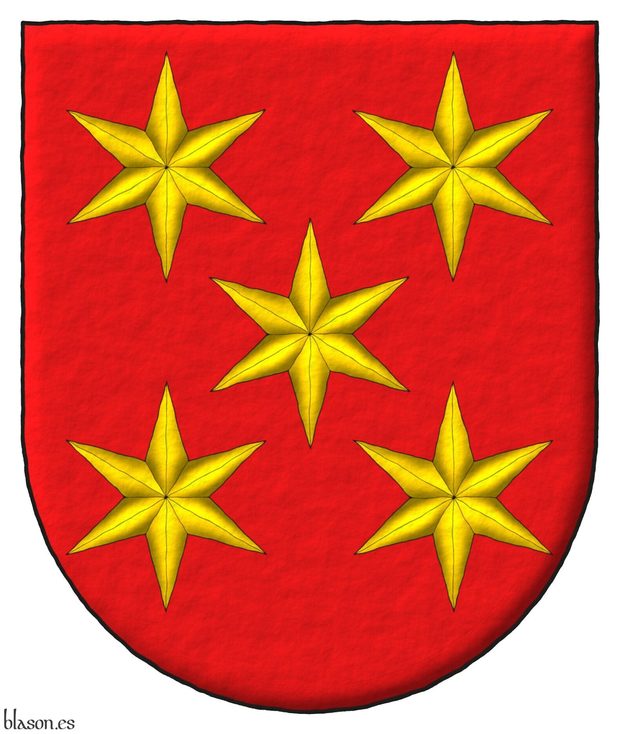
Blazon of the Freitas lineage of Portugal.
Gules, five mullets of six points Or.
Illuminated and a freehand finishing.
It can be found at [Cró, J. do; 1509; page 123].
Blazon keywords: Without divisions, Gules, Five, Mullet and Or.
Style keywords: Freehand, Outlined in sable, Illuminated and Semi-circular.
Classification: Interpreted, Lineage and Kingdom of Portugal.


Full achievement of the cadet branches of Fernando Durán Cabral de Melo e Alpoim
Quarterly: 1 Gules, a pale Or upon six waves Azure and Argent, a bordure Or charged with eight lions' heads erased Gules [for Durán]; 2 Azure, a crescent reversed Argent, in dexter chief a fleur de lis Or, a bordure Gules [for Alpoim]; 3 Argent, two goats in pale Purpure, horned Sable [for Cabral]; 4 Gules, a double cross throughout Or cantoned by six plates, a bordure Or [for Melo]; an inescutcheon Azure, five fleurs de lis Or. Crest: Upon a helm in profile Argent, with visor bars Or, and a wreath Or and Azure, an arm proper, vested Azure, lined Or, supporting a scroll Azure doubled Or, inscribed with the cry «Notre Dame du Puy» Or. Mantling: Azure doubled Or.
Arms depicted by me, highlighted with lights and shadows, contoured in Sable, with an ogee outer contour and with a freehand finish.
Blazon keywords: Gules, Or, Azure, Argent, One, Two, Five, Six, Seven, Eight, Quarterly, Pale, Upon, Wave, Bordure, Charged, Lion, Head, Erased, Crescent, Reversed, In the dexter chief, Fleur de lis, Goat, In pale, Horned, Double cross throughout, Cantoned, Plate, Inescutcheon, Upon (wreath), Helm, Facing dexter, Barred, Wreath, Arm, Proper, Vested, Lined, Grasping, Scroll, Doubled, Inscribed, War cry and Mantling.
Style keywords: Outlined in sable, Illuminated, Ogee and Freehand.
Classification: Personal, Lineage, Interpreted, Boa and Coat of arms.
Bearer: Durán Cabral de Melo e Alpoim, cadet branches of Fernando.


Gangoiti, lineage
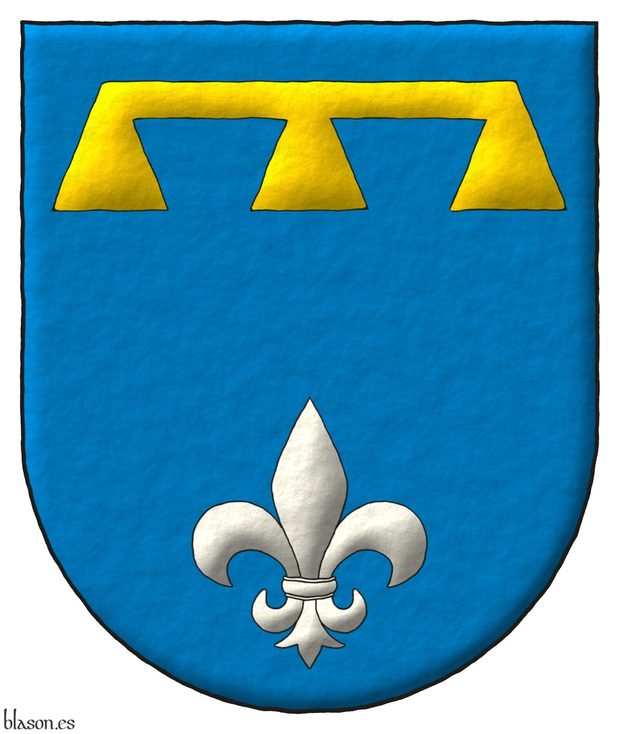
Azure, in chief a label Or, and in base a fleur de lis Argent.
Escudo de azur, en jefe un lambel de oro y en punta una flor de lis de plata.
Coat of arms painted by me, illuminated with lights and shadows, contoured in Sable, with a semi-circular outer contour and with a freehand finishing.
Coat of arms of the lineage Gangoiti emblazoned by me based on the description by [Cadenas y Vicent, V. de; 1987; page 770].
Blazon keywords: Azure, Or, Argent, One, In chief, Label, In base and Fleur de lis.
Style keywords: Outlined in sable, Illuminated, Semi-circular and Freehand.
Classification: Personal, Lineage, Interpreted, Boa and Coat of arms.
Bearer: Gangoiti, lineage.


![Ver [Garaycoa Raffo, L.; 2011] en referencias bibliográficas. Libro abierto, hojas de plata, filo de oro, guardas de gules, tapas de sable.](../css/Libro.Bibliografia.png)
Garaycoa Raffo, L.; 2011
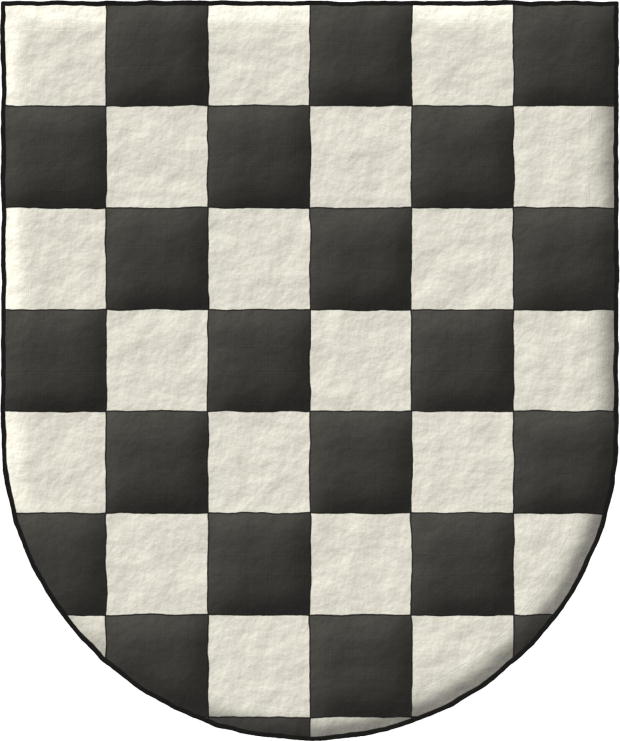
Lorenzo Garaycoa Raffo, Doctor, «Contribución Heraldica para el Estudio de la Sociedad Colonial de Guayaquil», pending to publish, graphic designer Lorenzo Garaycoa Taylor, with 320 surnames and 500 coat of arms, mainly of colonial coats of arms, main index on page 98, alphabetical index on page 99, 117 pages, Guayaquil, 11th of February of 2011.
Bibliographical reference of century XXI.
Classification: Castilian language and Black and white and color illustrations.
The author is Garaycoa Raffo, Lorenzo.
The following article cites this bibliographic reference:
Internal resources: GaraycoaRaffoL2011.pdf.


![Ver [García Carraffa, A.; García Carraffa, A.; 1920] en referencias bibliográficas. Libro abierto, hojas de plata, filo de oro, guardas de gules, tapas de sable.](../css/Libro.Bibliografia.png)
García Carraffa, A.; García Carraffa, A.; 1920
Alberto García Carraffa y Arturo García Carraffa, «Heraldic and Genealogical Dictionary of Spanish and American Surnames», 88 volumes, printed by Antonio Marzo, Madrid, 1920.
Contents of the 88 volumes
- Volume I. The science of heraldry or blazon.
- Volume II. Dictionary of blazonry terms; Methods of blazoning; Index of heraldic.
- Volume III. Aanda - Adan de Yarza.
- Volume IV. Adana - Aich.
- Volume V. Aichiaivoli - Alcocer.
- Volume VI. Alcoces - Almuzara.
- Volume VII. Aloi - Alzuru.
- Volume VIII. Allado - Anés.
- Volume IX. Anescar - Aragón.
- Volume X. Aragonés - Arecha.
- Volume XI. Aréchaga - Aronal.
- Volume XII. Aronsena - Azzia.
- Volume XIII. Baana - Barbena.
- Volume XIV. Barbens - Basani.
- Volume XV. Basanta - Benavides.
- Volume XVI. Bencarza - Blancazo.
- Volume XVII. Blanco - Bolet.
- Volume XVIII. Boliaga - Brañas.
- Volume XIX. Braramuño - Buzón.
- Volume XX. Caamaño - Cadelo.
- Volume XXI. Cadena - Campani.
- Volume XXII. Campano - Cañellas.
- Volume XXIII. Cañete - Caroli.
- Volume XXIV. Carondelet - Cassador.
- Volume XXV. Castant - Celaeta.
- Volume XXVI. Celain - Claver.
- Volume XXVII. Claveria - Cutuneguieta.
- Volume XXVIII. Chavelas - Desportell.
- Volume XXIX. Despou - Duzay.
- Volume XXX. Ebazquin - Ellauri.
- Volume XXXI. Ellul - Escolonea.
- Volume XXXII. Escorcia - Ezterripa.
- Volume XXXIII. Fabalis - Fernández de Espinosa.
- Volume XXXIV. Fernández de Estenoz - Figuereido.
- Volume XXXV. Figuera - Franco.
- Volume XXXVI. Francoli - Gamboa.
- Volume XXXVII. Gambacorta - García de la Plata.
- Volume XXXVIII. García y Portilla - Gil de Zúñiga.
- Volume XXXIX. Gilabert - Gómez de la Serna.
- Volume XL. Gómez de Silva - Gorriti.
- Volume XLI. Górriz - Guil.
- Volume XLII. Guilisagasti - Haro.
- Volume XLIII. Hartos - Hilera.
- Volume XLIV. Hilgueros - Ibarrundia.
- Volume XLV. Ibars de Povil - Irazusta.
- Volume XLVI. Irgas - Izurzu.
- Volume XLVII. Jabaloyas - Juyá.
- Volume XLVIII. Labaca - Larburu.
- Volume XLIX. Lardíes - Lazcamburu.
- Volume L. Lazcano - Lizárraga.
- Volume LI. Lizarralde - Luzuriaga.
- Volume LII. Llabiá - Malda.
- Volume LIII. Maldonado - Marín.
- Volume LIV. Marina - Marroquin.
- Volume LV. Marrubiza - Mendibure.
- Volume LVI. Mendicoa - Mesares.
- Volume LVII. Mescua - Moncayo.
- Volume LVIII. Monclares - Moradell.
- Volume LIX. Moraga - Mozo.
- Volume LX. Mozo de la Torre - Muzúa.
- Volume LXI. Naarruza - Nelia.
- Volume LXII. Neira - Ocaranza.
- Volume LXIII. Ocariz - Olcina.
- Volume LXIV. Olcinellas - Ordines.
- Volume LXV. Ordonias - Oruna.
- Volume LXVI. Oruña - Ozticain.
- Volume LXVII. Pablo or de Pablo - Palandegui or Palantegui.
- Volume LXVIII. Palafurgell - Parro.
- Volume LXIX. Parrondo - Pellón.
- Volume LXX. Pemán - Pérez de Arramendia.
- Volume LXXI. Pérez de Arroyo - Pillado.
- Volume LXXII. Pimentel - Poli.
- Volume LXXIII. Polo - Portero.
- Volume LXXIV. Portes - Puig - Gat.
- Volume LXXV. Puigbaco - Quincoces.
- Volume LXXVI. Quinquer - Rami.
- Volume LXXVII. Ramírez - Rezusta.
- Volume LXXVIII. Riabeyo - Rizo.
- Volume LXXIX. Roa - Romaza.
- Volume LXXX. Romero or Romeo, O Romeu - Ruy de Peras.
- Volume LXXXI. Sáa - Salinas.
- Volume LXXXII. Sall - Santángel or Sant Angel.
- Volume LXXXIII. Santaolaria or Santolaria - Sayola.
- Volume LXXXIV. Sebastián - Sirtema.
- Volume LXXXV. Sirvent or Sirvente - Susunaga.
- Volume LXXXVI. Tabar or Tavar - Tolosans.
- Volume LXXXVII. Tolrá - Tutor.
- Volume LXXXVIII. Uacué - Urriza.
Bibliographical reference of century XX.
Classification: Castilian language and Black and white with color plates.
The 2 authors are García Carraffa, Alberto and García Carraffa, Arturo.
External links:
Internal resources: GarciaCarrafiaAyA1920.Tomo.01.pdf PDF format, GarciaCarrafiaAyA1920.Tomo.04.pdf PDF format and GarciaCarrafiaAyA1920.Tomo.08.pdf PDF format.


![Ver [García Carraffa, A.; García Carraffa, A.; 1968] en referencias bibliográficas. Libro abierto, hojas de plata, filo de oro, guardas de gules, tapas de sable.](../css/Libro.Bibliografia.png)
García Carraffa, A.; García Carraffa, A.; 1968
Alberto García Carraffa y Arturo García Carraffa, with the colaboration of Armando de Fluviá y Escorsa, «El Solar Catalán, Valenciano y Balear», 4 volumes, Volume I Abad-Cebrián, 443 pages, Volume II Celma-Malda, 449 pages, Volume III Malendric-Quirant, 425 pages, Volume IV Rabasa-Zenarbe y apéndice, 516 pages, 1st edition, Heraldic Collection, edited by Librería Internacional, San Sebastián, 1968.
Bibliographical reference of century XX.
Classification: Castilian language and Black and white with color plates.
The 2 authors are García Carraffa, Alberto and García Carraffa, Arturo.
The following articles cite this bibliographic reference:
Internal resources: Paper book.


![Ver [Herrera Casado, A.; 1993] en referencias bibliográficas. Libro abierto, hojas de plata, filo de oro, guardas de gules, tapas de sable.](../css/Libro.Bibliografia.png)
Herrera Casado, A.; 1993
Antonio Herrera Casado, «The Armorial of Aragon», Annals of the Royal Matritense Academy of Heraldry and Genealogy, pages 137-220, Madrid, 1992-1993.


Ignasi Pujol, comparation
[ Azure, a mount issuant from the base, in chief a fleur the lis Argent ] and [ Party per chevron Azure and Or, in chief a fleur de lis Argent, in base four pallets Gules ].
The coat of arms of Ignasi Pujol was designed by him based on the ancient arms of the Pujol lineage, 1st image, and refined and emblazoned by me, 2nd image. The comparison of the blazon of the Pujol lineage with the blazon for Ignasi Pujol is the following.
Blazon keywords: Azure, Argent, Or, Gules, One, Mount, Issuant from base, In chief, Party per chevron, Fleur de lis, In base, Pallet and Pale.
Style keywords: Outlined in sable and Illuminated.
Classification: Lineage, Personal, Compare, Interpreted, Coat of arms and Boa.
Bearer: Pujol, Ignasi.


Janovsti of Janovic of Czechia, lineage
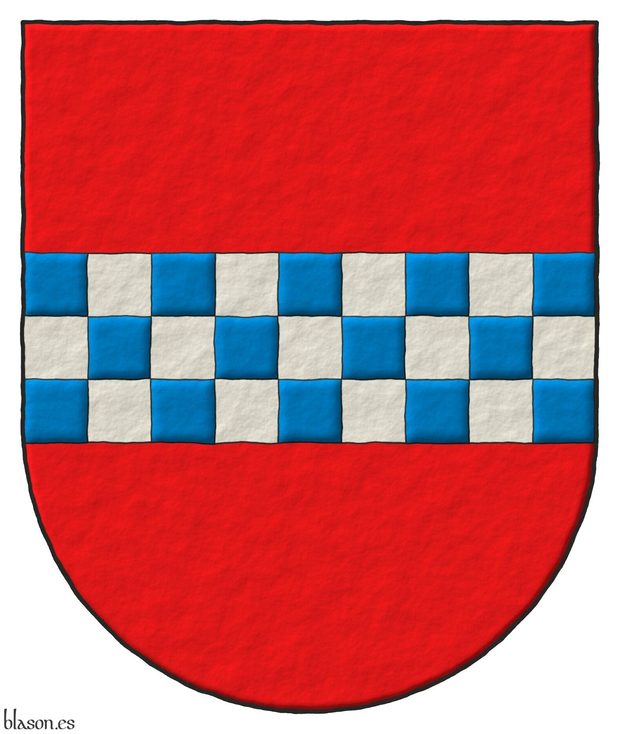
Gules, a fess chequey Azure and Argent.
Escudo de gules, una faja ajedrezada de azur y plata.
Arms emblazoned by me, highlighted with lights and shadows, contoured in Sable, with a semi-circular outer contour and with a freehand finish.
Coat of arms of the lineage Janovsti of Janovic of Czechia. It is also the coat of arms of the lineage Klenovsky of Klenove of Czech. I have emblazoned it with a fess chequy of 3 rows, symmetric and with 9 columns of squares, provided that its height is 1/3 of the width of the coat of arms.
Blazon keywords: Gules, Azure, Argent, One, Three, Nine, Fess and Chequey.
Style keywords: Outlined in sable, Illuminated, Semi-circular and Freehand.
Classification: Personal, Lineage, Interpreted, Boa and Coat of arms.
Bearer: Janovsti of Janovic of Czechia, lineage.
Blazon equivalent to: Lindsay of Scotland, lineage.


Larre, lineage of Bayonne, French Basque Country
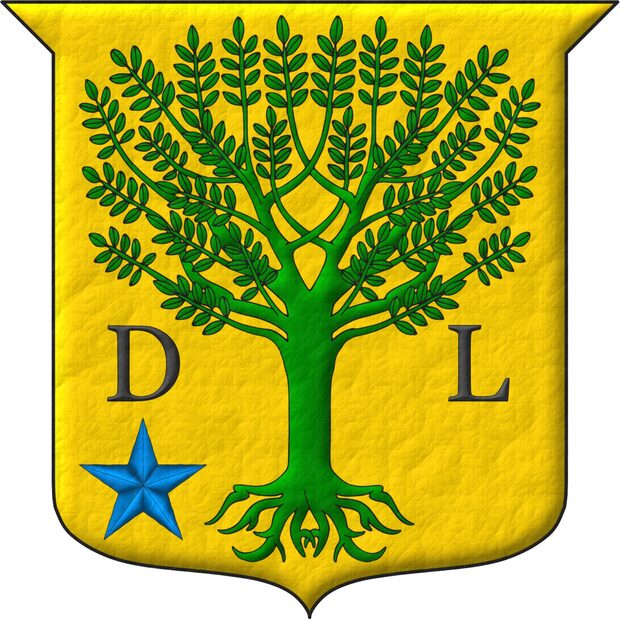
D'or à un arbre arraché de sinople, accosté à dextre de la lettre capitale «D» et à senestre de la lettre capitale «L» du même, et une étoile d'azur posée au canton dextre de la pointe.
Or, a tree eradicated Vert between a capital letter «D» and a capital letter «L» Sable, in the dexter of the base a mullet Azure.
Illuminated with lights and shadows and with a leather finish.
Blazon keywords: Without divisions, Or, One, Tree, Erased, Vert, Between, Letter, Sable, Canton, Dexter, Base (lower 1/3), Mullet, Five and Azure.
Style keywords: Leather, Outlined in sable, Illuminated and Semi-circular.
Classification: Interpreted, Lineage and Kingdom of France.


Laydin, lineage
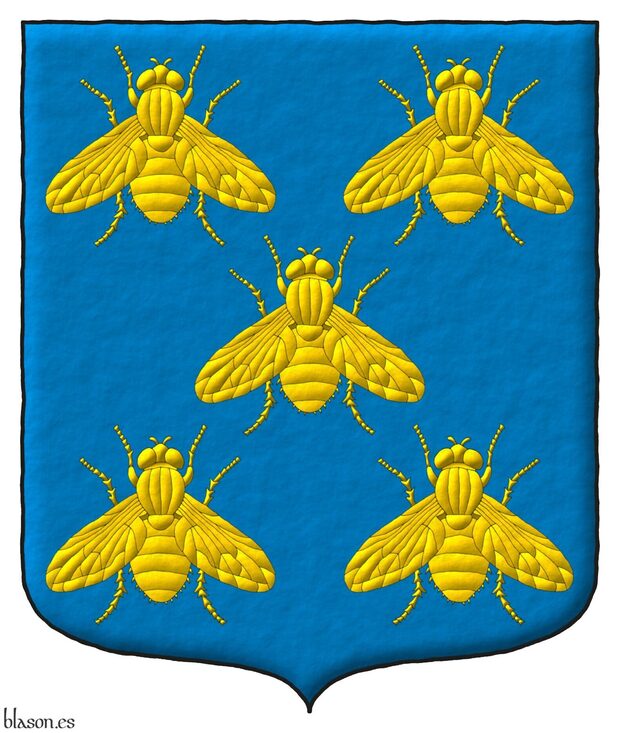
Azure, five flies in saltire Or.
Escudo de azur, cinco moscas puestas en sotuer de oro.
Arms painted by me, highlighted with lights and shadows, contoured in Sable, with an ogee outer contour and with a freehand finish.
This is the coat of arms of the lineage Laydin emblazoned by me, as described in [Cadenas y Vicent, V. de; 1987; page 989], whose blazon is equivalent to that of the Zendreros lineage, also described in [Cadenas y Vicent, V. de; 1987; page 1941].
Blazon keywords: Azure, Or, Five, Fly and In saltire.
Style keywords: Outlined in sable, Illuminated, Ogee and Freehand.
Classification: Personal, Lineage, Interpreted, Boa and Coat of arms.
Bearer: Laydin, lineage.


Lazaro of Aragon, lineage
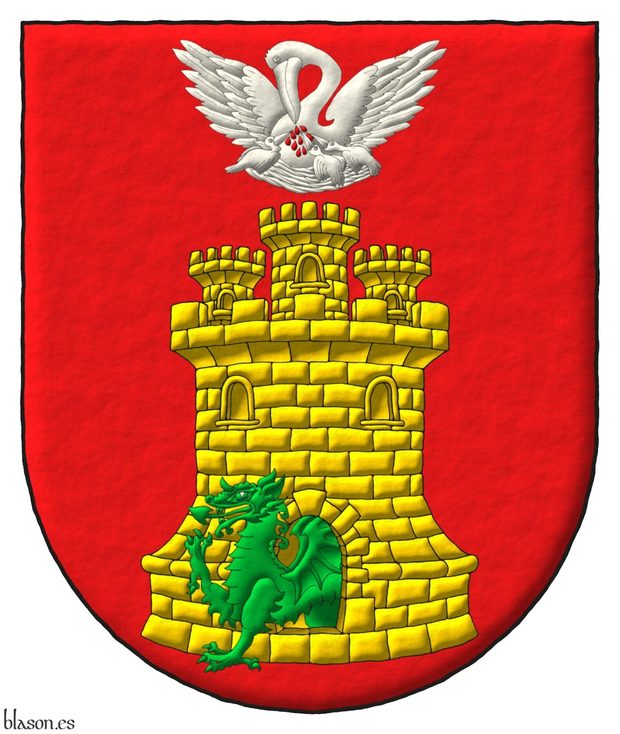
Gules, a castle triple-towered Or, masoned Sable, issuant from its port a dragon passant Vert, in chief a pelican in her piety Argent, vulned Gules.
Escudo de gules, un castillo de oro, mazonado de sable y saliendo por su puerta un dragón pasante de sinople, en jefe un pelícano desplegado de plata, la piedad de gules.
Coat of arms interpreted by me, highlighted with lights and shadows, outlined in Sable, with a semi-circular outer contour and with a freehand finishing.
Ancient arms of the lineage Lazaro of Aragon emblazoned by me.
Blazon keywords: Gules, Or, Vert, Argent, One, Castle, Triple-towered, Masoned, Issuant (port), Dragon, Passant, In chief, Pelican in her piety and Pelican.
Style keywords: Outlined in sable, Illuminated, Semi-circular and Freehand.
Classification: Personal, Lineage, Interpreted, Boa and Coat of arms.
Bearer: Lazaro of Aragon, lineage.


Lindsay of Scotland, lineage
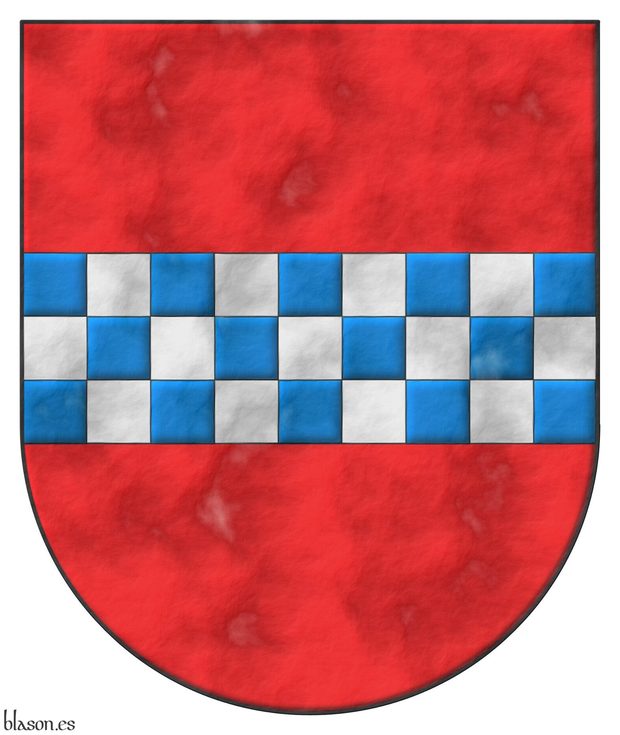
Gules, a fess chequey Azure and Argent.
Escudo de gules, una faja ajedrezada de azur y plata.
Arms depicted by me, highlighted with lights and shadows, outlined in Sable, with a semi-circular external shape and with a parchment finishing.
Coat of arms of the lineage Lindsay of Scotland. I have emblazoned it with a fess chequy of 3 rows, symmetric and with 9 columns of squares, provided that its height is 1/3 of the width of the coat of arms.
Blazon keywords: Gules, Azure, Argent, One, Three, Nine, Fess and Chequey.
Style keywords: Outlined in sable, Illuminated, Semi-circular and Parchment.
Classification: Personal, Lineage, Interpreted, Boa and Coat of arms.
Bearer: Lindsay of Scotland, lineage.
Blazon equivalent to: Janovsti of Janovic of Czechia, lineage.


Lindsay of the Byres, lineage
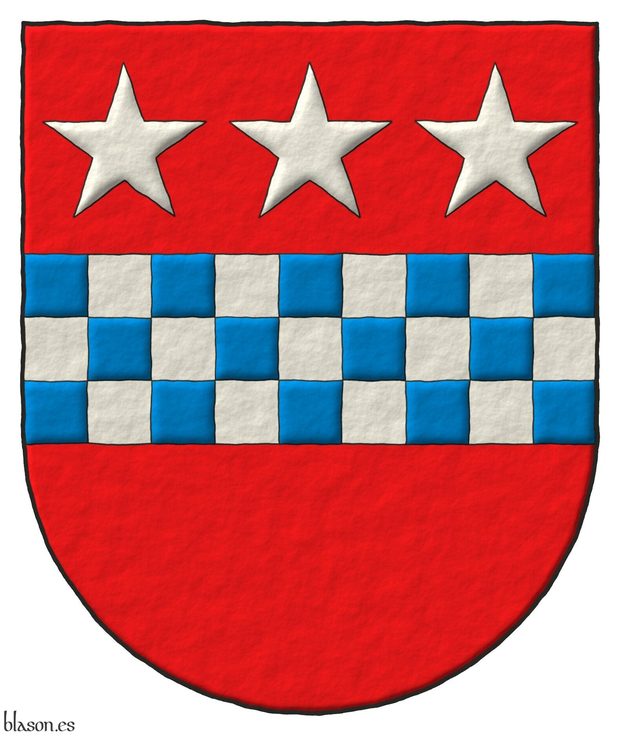
Gules, a fess chequey Azure and Argent, in chief three mullets of five points Argent.
Escudo de gules, una faja ajedrezada de azur y plata, en jefe tres estrellas de cinco puntas de plata.
Arms interpreted by me, highlighted with lights and shadows, outlined in Sable, with a semi-circular outer contour and with a freehand finish.
Coat of arms of the lineage Lindsay of the Byres. I have emblazoned it with a fess chequy of 3 rows, symmetric and with 9 columns of squares, provided that its height is 1/3 of the width of the coat of arms.
Blazon keywords: Gules, Azure, Argent, One, Three, Nine, Fess, Chequey, In chief and Mullet.
Style keywords: Outlined in sable, Illuminated, Semi-circular and Freehand.
Classification: Personal, Lineage, Interpreted, Boa and Coat of arms.
Bearer: Lindsay of the Byres, lineage.


Lineage Argüello of Extremadura
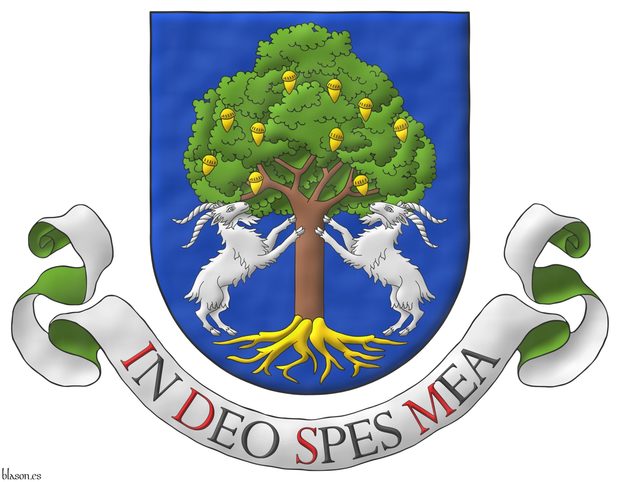
Azure, a holm oak proper, fructed and eradicated Or, between two goats Argent supporting it. Motto: «In Deo Spes Mea».
Escudo de azur, una encina al natural, frutada y arrancada de oro, con dos cabras de plata empinadas al tronco. Lema: «In Deo Spes Mea».
Coat of arms depicted by me, highlighted with lights and shadows, outlined in Sable, with a semi-circular external shape and with a watercolor finish.
Coat of arms of the lineage Argüello of Extremadura emblazoned by me. This motto was found by Eleonora on a pair of Chinese porcelain plates made for the Spanish market, Qianlong period, circa 1770, which bear the arms of the Argüello lineage.
Blazon keywords: Azure, Or, Argent, One, Two, Holm oak, Proper, Fructed, Eradicated, Goat, Supporting and Motto.
Style keywords: Outlined in sable, Illuminated, Semi-circular and Watercolor.
Classification: Personal, Lineage, Interpreted, Boa and Coat of arms.
Bearer: Argüello of Extremadura, lineage.


Lineage Rawson
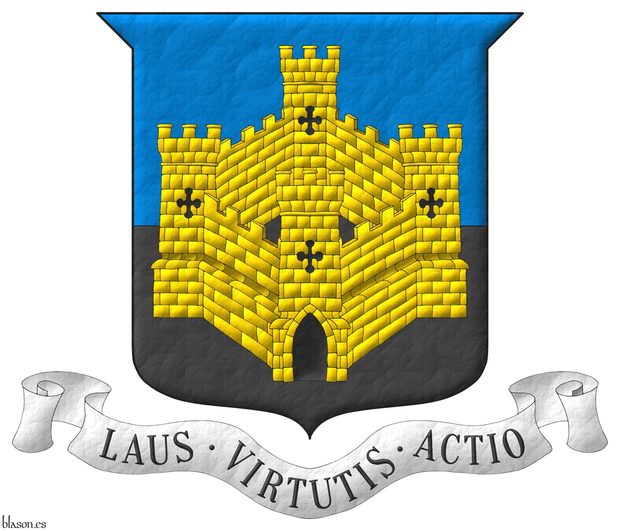
Party per fess Azure and Sable, overall a four-towered castle Or, port and windows Sable. Motto: «Laus · Virtutis · Actio».
Escudo cortado de azur y sable, brochante sobre la partición un castillo de cuatro torres de oro, aclarado de sable. Lema: «Laus · Virtutis · Actio».
Arms emblazoned by me, illuminated with lights and shadows, outlined in Sable, with an ogee triple-pointed external shape and with a leather finish.
Blazon keywords: Azure, Sable, Or, One, Party per fess, Overall, Four-towered, Castle, Port and windows and Motto.
Style keywords: Outlined in sable, Illuminated, Ogee Triple-Pointed and Leather.
Classification: Personal, Lineage, Interpreted, Boa and Coat of arms.
Bearer: Rawson, Lineage.


Lineage Terraza of Aragon, outlined
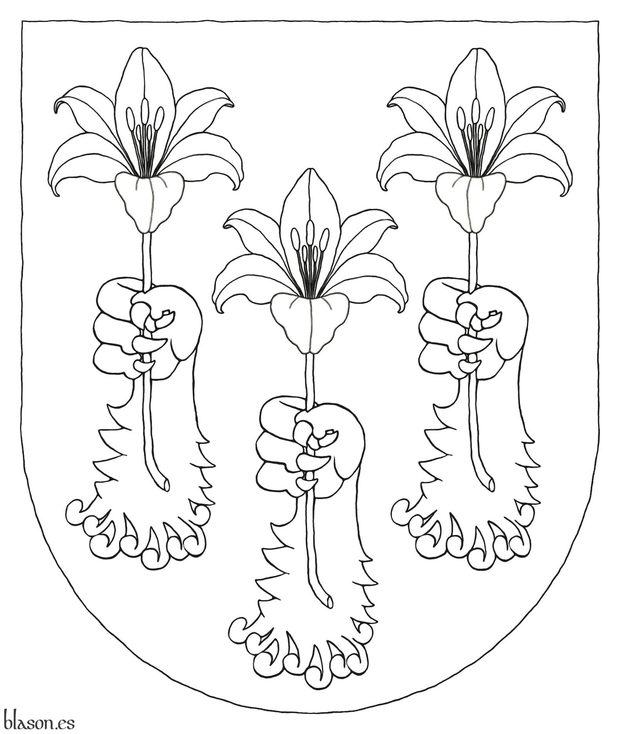
Or, three lion’s paws erect and erased Or, 2 and 1, each grasping a Madonna lily Argent.
Coat of arms of the lineage Terraza of Aragon, outlined by me following the instructions of Enrique de Alzaga Aliena.
Blazon keywords: Azure, Or, Argent, Three, One, Lion, Paw, Erect, Erased, Ordered, Grasping and Madonna lily.
Style keywords: Outlined, Outlined in sable and Semi-circular.
Classification: Personal, Lineage, Interpreted, Boa and Coat of arms.
Bearer: Terraza of Aragon, lineage.


Malvin de Montazet, lineage of Languedoc
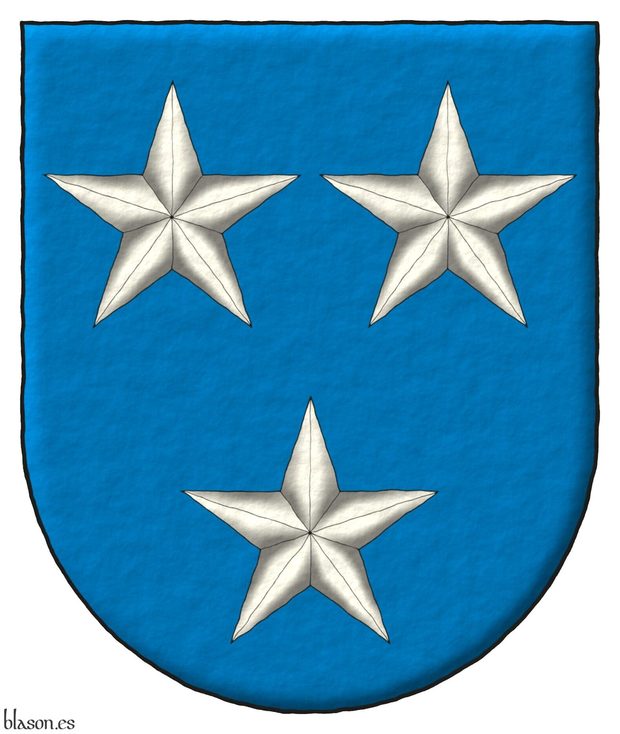
Blazon of the Malvin de Montazet lineage of Languedoc, France.
Azure, three mullets Argent, 2 and 1.
Illuminated and a freehand finishing.
Its French blazon «d'azur, à trois étoiles d'argent, 2 et 1» can be found at [Rietstap, J. B.; 1861; page 140].
Blazon keywords: Without divisions, Azure, Three, Mullet, Argent and Ordered.
Style keywords: Freehand, Outlined in sable, Illuminated and Semi-circular.
Classification: Interpreted, Lineage and Kingdom of France.


Mark of Germany, lineage
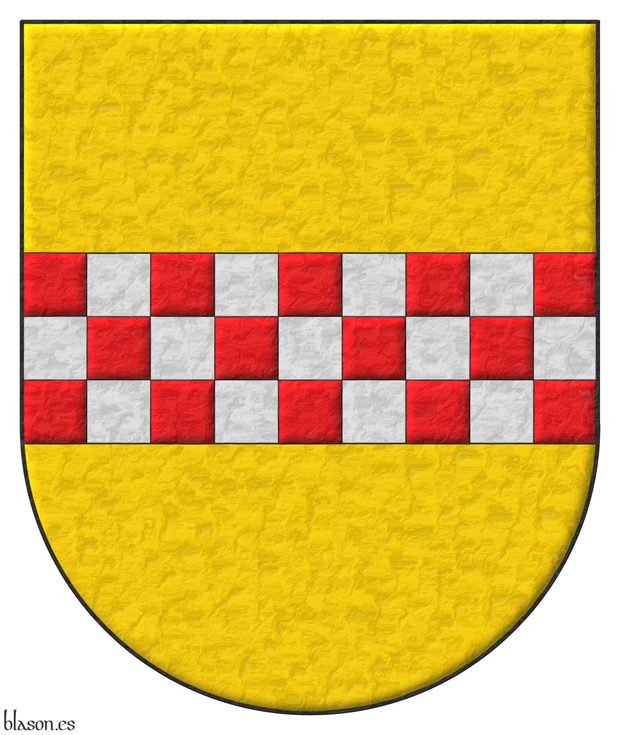
Or, a fess chequey Gules and Argent.
Escudo de oro, una faja ajedrezada de gules y plata.
Arms depicted by me, highlighted with lights and shadows, contoured in Sable, with a semi-circular external shape and with a metal beaten finishing.
Coat of arms of the lineage Mark of Germany. I have emblazoned it with a fess chequy of 3 rows, symmetric and with 9 columns of squares, provided that its height is 1/3 of the width of the coat of arms.
Blazon keywords: Or, Gules, Argent, One, Three, Nine, Fess and Chequey.
Style keywords: Outlined in sable, Illuminated, Semi-circular and Metal beaten.
Classification: Personal, Lineage, Interpreted, Boa and Coat of arms.
Bearer: Mark of Germany, lineage.


Mascarenhas, lineage of Portugal
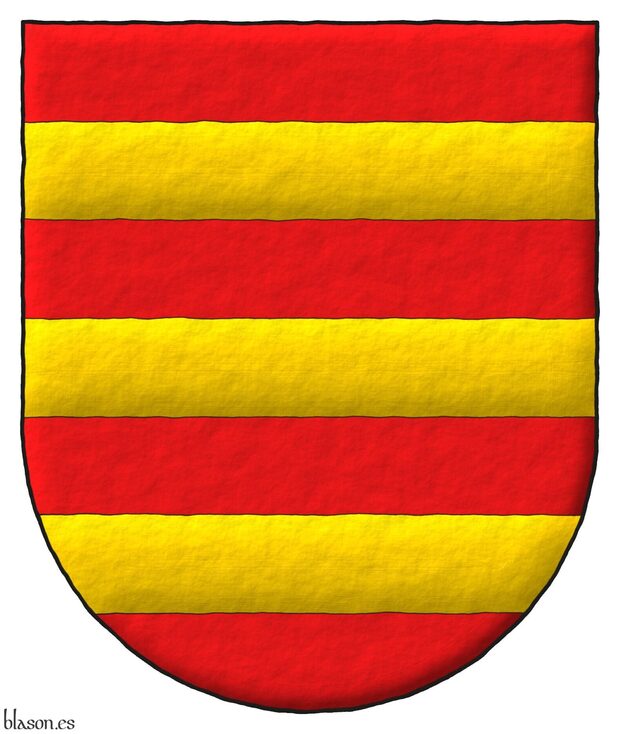
Blazon of the Mascarenhas lineage of Portugal.
Gules, three bars Or.
Illuminated and a freehand finishing.
It can be found at [Cró, J. do; 1509; page 77].
Blazon keywords: Without divisions, Gules, Three, Fess and Or.
Style keywords: Freehand, Outlined in sable, Illuminated and Semi-circular.
Classification: Interpreted, Lineage and Kingdom of Portugal.


Melo, lineage

Gules, a double cross throughout Or cantoned by six plates, a bordure Or.
Escudo de gules, una cruz doble y plena de oro cantonada de seis bezantes de plata, una bordura de oro.
Coat of arms emblazoned by me, highlighted with lights and shadows, contoured in Sable, with an ogee outer contour and with a freehand finish.
Coat of arms of the lineage Melo. This coat of arms has been created for Fernando Durán Cabral de Mello d’Alpoim as a preparatory work for his armorial bearings where the arms of Melo are in the 4th quarter.
Blazon keywords: Gules, Or, Argent, One, Six, Double cross throughout, Cantoned, Plate and Bordure.
Style keywords: Outlined in sable, Illuminated, Ogee and Freehand.
Classification: Personal, Lineage, Interpreted, Boa and Coat of arms.
Bearer: Melo, lineage.


![Ver [Mogrobejo Zabala, E. de; 1991] en referencias bibliográficas. Libro abierto, hojas de plata, filo de oro, guardas de gules, tapas de sable.](../css/Libro.Bibliografia.png)
Mogrobejo Zabala, E. de; 1991
Endika de Mogrobejo Zabala, «Blasones y Linajes de Euskalerria», 10 volumes, Volume I A-Alcerreca, Volume II Alciba-Angui, Volume III Angulo-Astu, Volume IV Astun-Bun, Volume V Busta-Elua, Volume VI Elus-Gorniz, Volume VII Gordu-Laca, Volume VIII Lacar-Merca, Volume IX Mere-Salez, Volume X Salinas-Z, edited by Editorial Amigos del Libro Vasco, printed by Grafo SA, ISBN of the complete work 84-7886-026-6, legal Deposit BI-469-1991, Bilbao, 1991.
Bibliographical reference of century XX.
Classification: De bibliotheca, Black and white with color plates and Castilian language.
Author: Mogrobejo Zabala, Endika de.


Ormazabal of the Basque Country, lineage
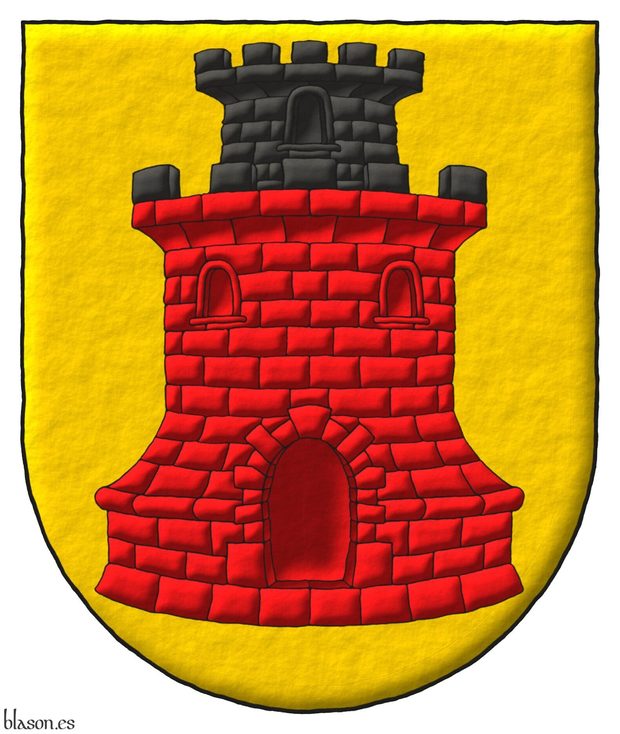
Or, a tower Gules, embattled, masoned and with a turret Sable.
Escudo de oro, una torre de gules, almenada, mazonada y donjonada de sable.
Coat of arms emblazoned by me, highlighted with lights and shadows, outlined in Sable, with a semi-circular outer contour and with a freehand finishing.
Ancient arms of the lineage Ormazabal of the Basque Country emblazoned by me.
Blazon keywords: Or, Gules, Sable, One, Tower, Embattled, Masoned and With a turret.
Style keywords: Outlined in sable, Illuminated, Semi-circular and Freehand.
Classification: Personal, Lineage, Interpreted, Boa and Coat of arms.
Bearer: Ormazabal of the Basque Country, lineage.


Orrantia of the Basque Country, lineage
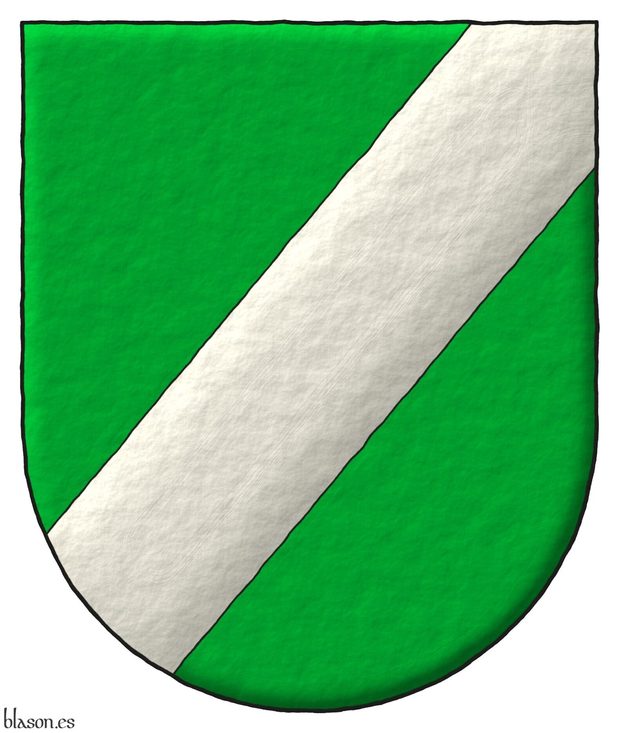
Vert, a bend sinister Argent.
Escudo de sinople, una barra de plata.
Coat of arms emblazoned by me, illuminated with lights and shadows, outlined in Sable, with a semi-circular outer contour and with a freehand finishing.
Coat of arms of the lineage Orrantia of the Basque Country emblazoned by me.
Blazon keywords: Vert, Argent, One and Bend sinister.
Style keywords: Outlined in sable, Illuminated, Semi-circular and Freehand.
Classification: Personal, Lineage, Interpreted, Boa and Coat of arms.
Bearer: Orrantia of the Basque Country, lineage.


Osona, lineage
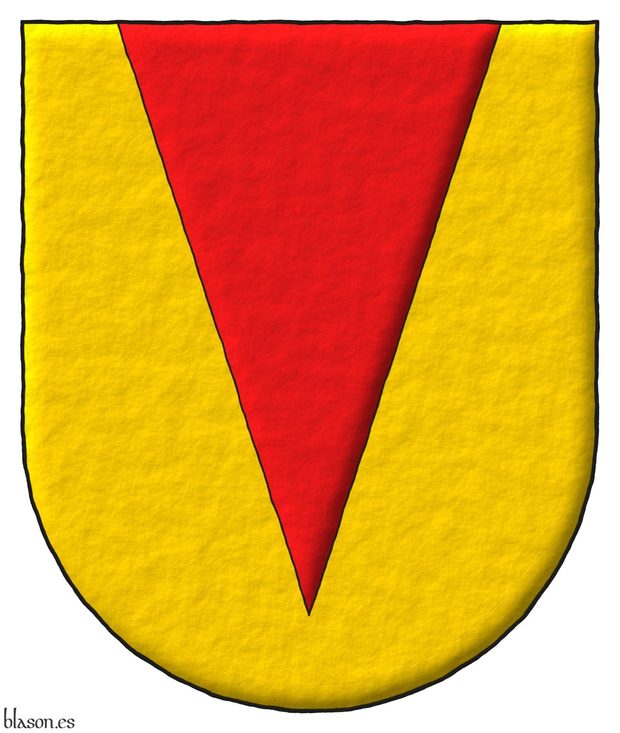
Or, a pile Gules.
Escudo de oro, una pila de gules.
Coat of arms emblazoned by me, illuminated with lights and shadows, contoured in Sable, with a semi-circular external shape and with a freehand finishing.
Coat of arms of the lineage Osona emblazoned by me based on the description by [Cadenas y Vicent, V. de; 1987; page 1325].
Blazon keywords: Or, Gules, One and Pile.
Style keywords: Outlined in sable, Illuminated, Semi-circular and Freehand.
Classification: Personal, Lineage, Interpreted, Boa and Coat of arms.
Bearer: Osona, lineage.


Peraza of Cantabria, lineage
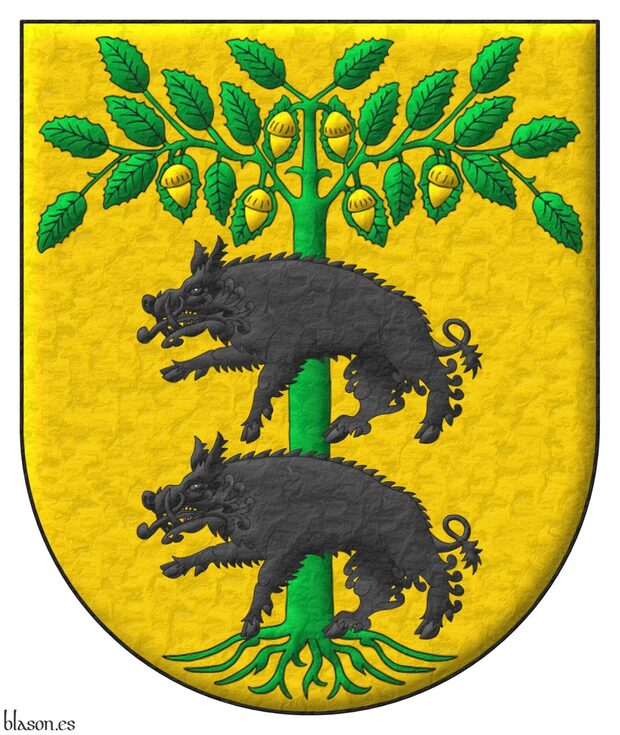
Or, a holm oak eradicated Vert, fructed Or, in front of its trunk two boars passant, in pale Sable.
Escudo de oro, una encina arrancada de sinople, frutada de oro, atravesados a su tronco dos jabalíes pasantes, en palo de sable.
Arms depicted by me, illuminated with lights and shadows, outlined in Sable, with a semi-circular outer contour and with a metal beaten finish.
Ancient arms of the lineage Peraza of Cantabria emblazoned by me. I have painted the acorns in Or metal on the Vert leaves so that they stand out, as they would not on the Or metal field. I often write expressions such as metal Or and color Vert, specifying which are metals and which are colors, to take into account the rule of tinctures.
Blazon keywords: Or, Vert, Sable, Holm oak, Eradicated, Fructed, In front (tree), Trunk, Boar, Passant and In pale.
Style keywords: Outlined in sable, Illuminated, Semi-circular and Metal beaten.
Classification: Personal, Lineage, Interpreted, Boa and Coat of arms.
Bearer: Peraza of Cantabria, lineage.


Poumola, lineage of Catalonia
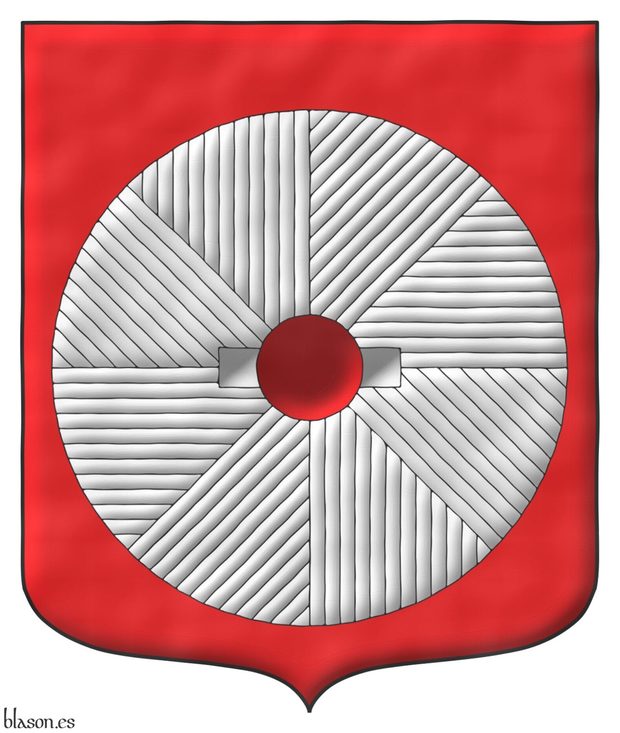
Blazon of the Poumola lineage of Catalonia.
Gules, a millstone Argent.
Escudo de gules, una piedra de molino de plata.
Illuminated and a watercolor finishing with shadow in the hole.
It blazon is describe in [Cadenas y Vicent, V. de; 1987; page 1429], [García Carraffa, A.; García Carraffa, A.; 1968; volume 3, page 358], and [Ferrer i Vives, F.; 1995; volume 2, page 362].
In this case, my theory is that this coat of arms is an example of «canting arms». «Canting arms» use a word or words of the surname or inside the surname to make the coat of arms. The surname Poumola is from Catalonia, we can split the surname into 2 parts «pou-mola», in Catalonian language a) «pou» means «well» and b) «mola» means «millstone» ~ «cadascuna de les dues pedres de forma circular que componen el molí», [GDLC; 1998], and this could be the reason of the symbolism of this coat of arms. «Canting» in heraldry means «talking» or «chatting», in Spanish «canting arms» is translated as «armas parlantes». Some heralds call «canting» to this creative technic.
Blazon keywords: Without divisions, Gules, One, Millstone and Argent.
Style keywords: Watercolor, Outlined in sable, Illuminated and Ogee.
Classification: Interpreted, Lineage and Canting.


![Ver [Rietstap, J. B.; 1861] en referencias bibliográficas. Libro abierto, hojas de plata, filo de oro, guardas de gules, tapas de sable.](../css/Libro.Bibliografia.png)
Rietstap, J. B.; 1861
Johannes Baptista Rietstap, «Armorial général, précedé d'un Dictionnaire des termes du blason», edited by Gerrit Benjamin van Goor, 2 volumes, Volume I from A to K, 1149 páginas, Volume II from L to Z, 1316 páginas, Gouda, 1861.
Bibliographical reference of century XIX.
Classification: French language.
The author is Rietstap, Johannes Baptista.
The following articles cite this bibliographic reference:
- Ackerson - Akers, lineage
- Amancier, lineage of Genevois
- Amitay Edward von Stiebel, collage
- Lineage Baldovino from Venecia, plain tincture
- Lineage Baldovino from Venecia, schema 2x2
- Malvin de Montazet, lineage of Languedoc
- Oschoven of the Rhin
- Talbot, lineage of England
- Urban V
External links:
- Deuxième édition refondue et augmentée, 1884-1887, volume I, A-K.
- Deuxième édition refondue et augmentée, 1884-1887, volume II, L-Z.
- Gerrit Benjamin van Goor.
Internal resources: RietstapJB1861.10.ArmorialGeneral.A.Z.txt in ASCII format in French with 126,068 blazons, RietstapJB1861.10.ArmorialGeneral.A.Z.doc in Word format in French, RietstapJB1861.11.ArmorialGeneral.A.K.pdf in PDF format in French, RietstapJB1861.12.ArmorialGeneral.L.Z.pdf in PDF format in French and physical book on paper, 2 volumes.


Rivas of Aragon, lineage
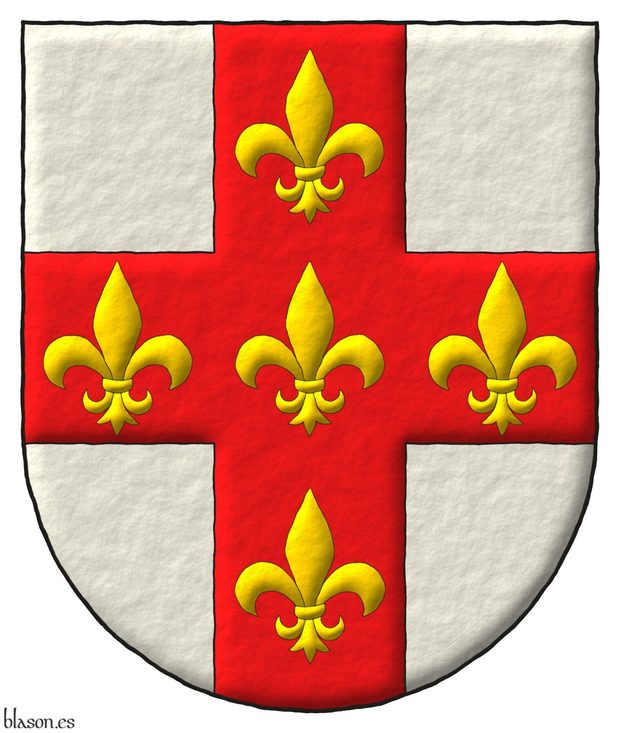
Argent, on a cross Gules five fleurs de lis Or.
Escudo de oro, una cruz de gules cargada de cinco flores de lis de oro.
Arms depicted by me, illuminated with lights and shadows, contoured in Sable, with a semi-circular outer contour and with a freehand finish.
Ancient arms of the lineage Rivas of Aragon emblazoned by me. Alternative blazon: «Argent, a cross Gules charged with five fleurs de lis Or».
Blazon keywords: Argent, Gules, Or, One, Five, Cross, Charged and Fleur de lis.
Style keywords: Outlined in sable, Illuminated, Semi-circular and Freehand.
Classification: Personal, Lineage, Interpreted, Boa and Coat of arms.
Bearer: Rivas of Aragon, lineage.


Robertson of Struan, lineage
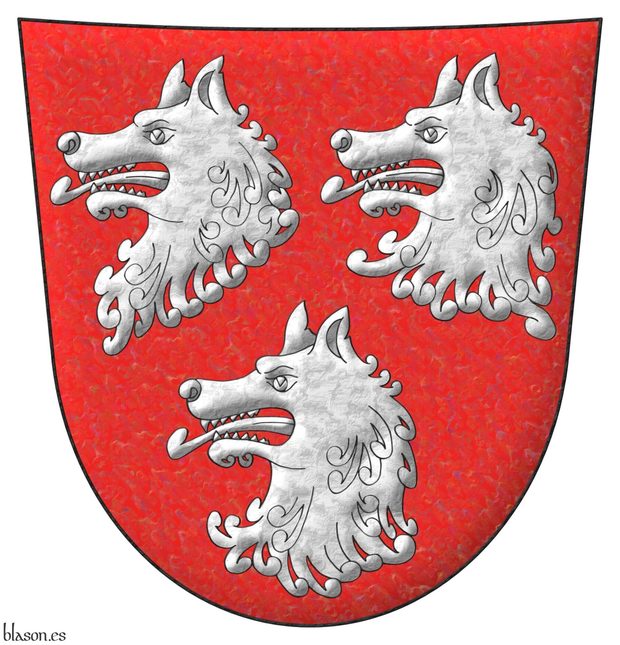
Gules, three wolves' heads erased Argent.
Escudo de gules, tres cabezas de lobo arrancadas de plata.
Arms interpreted by me, illuminated with lights and shadows, outlined in Sable, with a rounded trapezoidal outer contour and with a metal and iridescent finish.
Blazon keywords: Gules, Argent, Three, Wolf, Head and Erased.
Style keywords: Outlined in sable, Illuminated, Rounded trapezoid and Metal and iridescent.
Classification: Personal, Kingdom of Scotland, Lineage, Interpreted, Boa and Coat of arms.
Bearer: Robertson of Struan, lineage.


Rodelo lineage from Galicia, color Gules and metal Or
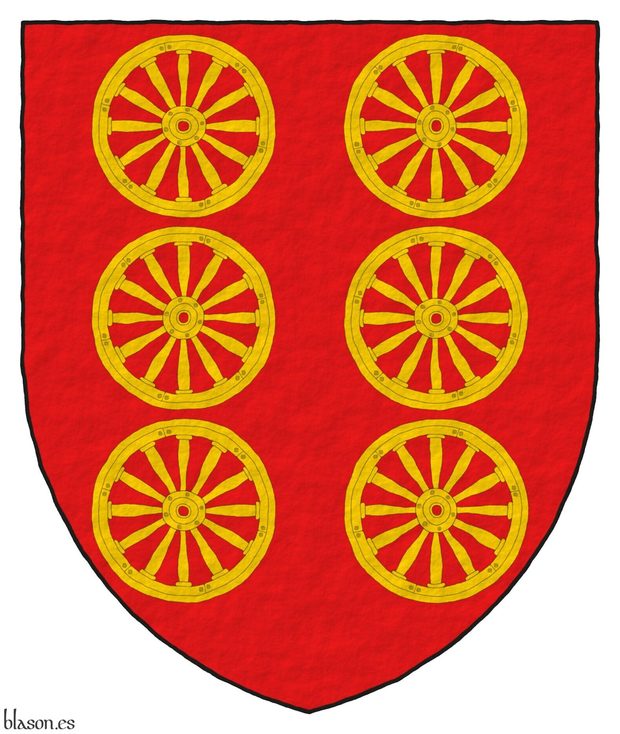
Gules, six wagon-wheels Or, 2, 2, and 2.
Escudo de gules, seis ruedas de carro de oro, 3 y 3.
I have always thought that they are canting arms because of the similar sounds between «rodelo», «rodar»~«rolling», and «rueda»~«wheel».
The expression «Heralds don’t pun – they cant» is itself a form of wordplay. At first glance, one might think that «cant» derives from «can’t», meaning that heralds cannot make puns. However, in heraldry, «cant» refers to the practice of creating a coat of arms that visually alludes to the bearer’s name, surname, or sometimes to a toponym. Such arms are known as «canting arms» ~ «armas parlantes» in Castilian. For example, if one were to design a coat of arms for someone named Megan Fox, and considering that the name Megan derives from Margaret, meaning «pearl» in Greek, a possible canting design could include a fox surrounded by a bordure of pearls. In this sense, canting arms represent the heraldic equivalent of verbal wordplay. Thus, «heralds do not pun — they cant».
Blazon keywords: Gules, Six, Wagon-wheel and Or.
Style keywords: Outlined in sable, Plain tincture and Pointed.
Classification: Lineage, Interpreted, Canting and Coat of arms.
Bearer: Rodelo lineage from Galicia.


Rothstein, lineage
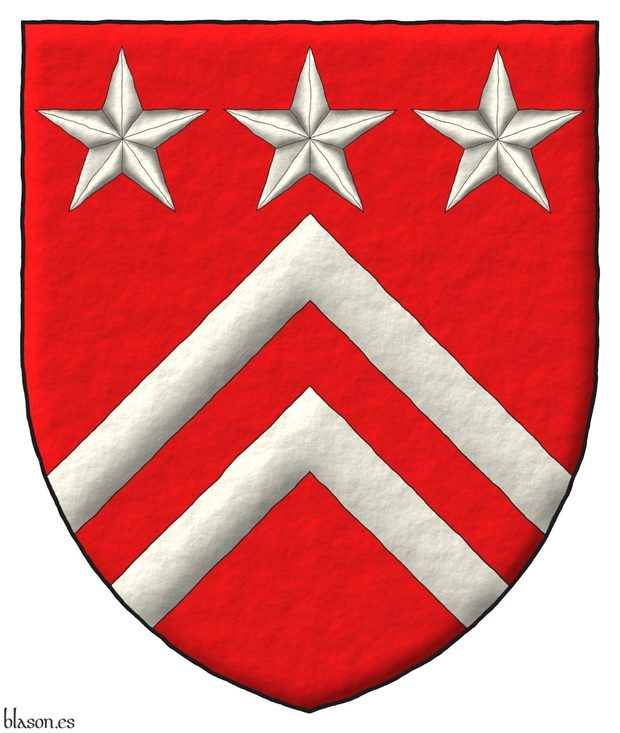
Gules, two chevronels, in chief three mullets Argent.
Escudo de gules, dos tenazas de plata, en jefe tres estrellas todo de plata.
Coat of arms depicted by me, highlighted with lights and shadows, contoured in Sable, with a pointed external shape and with a freehand finish.
The coat of arms of Rothstein lineage emblazoned by me.
Blazon keywords: Gules, Argent, Two, Three, Chevronel, In chief and Mullet.
Style keywords: Outlined in sable, Illuminated, Pointed and Freehand.
Classification: Personal, Lineage, Interpreted, Boa and Coat of arms.
Bearer: Rothstein, lineage.


![Ver [Sarandeses Pérez, F.; 1966] en referencias bibliográficas. Libro abierto, hojas de plata, filo de oro, guardas de gules, tapas de sable.](../css/Libro.Bibliografia.png)
Sarandeses Pérez, F.; 1966
Francisco Sarandeses Pérez, of the Institute of Asturian Studies and of the International Institute of Genealogy and Heraldry, «Heraldry of Asturian Surnames», 408 pages, black and white illustrations, 27 centimeters, includes bibliography and indexes, foreword by H.R.H. The Duke of Calabria, prologue by The Hon. Mr. Julio de Atienza, Baron of Cobos de Belchite, photographs by Mr. Jesús González-Galatea, published by the Asturian Studies Institute of the José María Quadrado Trust, Superior Center for Scientific Research, Provincial Council of Oviedo, printed by Gráficas Europa. Legal Deposit S. 137-1966, Oviedo, 1966.
Cover of the original 1966 edition reproduced in the second facsimile edition of 1994.
Bibliographical reference of century XX.
Classification: Castilian language and In black and white.
Author: Sarandeses Pérez, Francisco.
Bibliographical reference mentioned in the following article:

![Ver [Sarandeses Pérez, F.; 1994] en referencias bibliográficas. Libro abierto, hojas de plata, filo de oro, guardas de gules, tapas de sable.](../css/Libro.Bibliografia.png)
Sarandeses Pérez, F.; 1994
Francisco Sarandeses Pérez, of the Institute of Asturian Studies and of the International Institute of Genealogy and Heraldry, «Heraldry of Asturian Surnames», 408 pages, 89 color plates, black and white illustrations, 27 centimeters, includes bibliography and indexes. prologue to the facsimile edition by Dolores Duque de Estrada Castañeda and Fernando Alós Merry del Val, facsimile edition published by the Royal Institute of Asturian Studies of the José María Quadrado Trust, Superior Center for Scientific Research, printed by Eujoa Artes Gráficas, ISBN 84-87212-26-3, Legal Deposit AS.-1.309/94, Oviedo, 1994.
Reference to the original edition of 1966
The facsimile edition faithfully reproduces the original 1966, [Sarandeses Pérez, F.; 1966], published by the Provincial Council of Oviedo, with a foreword by H.R.H. The Duke of Calabria, prologue by The Hon. Mr. Julio de Atienza, Baron of Cobos de Belchite, and photographs by Mr. Jesús González-Galatea.
Bibliographical reference of century XX.
Classification: De bibliotheca, Castilian language and Black and white with color plates.
The author is Sarandeses Pérez, Francisco.
Internal resources: A facsimile edition as a physical book on paper.


Stewart of Scotland, lineage
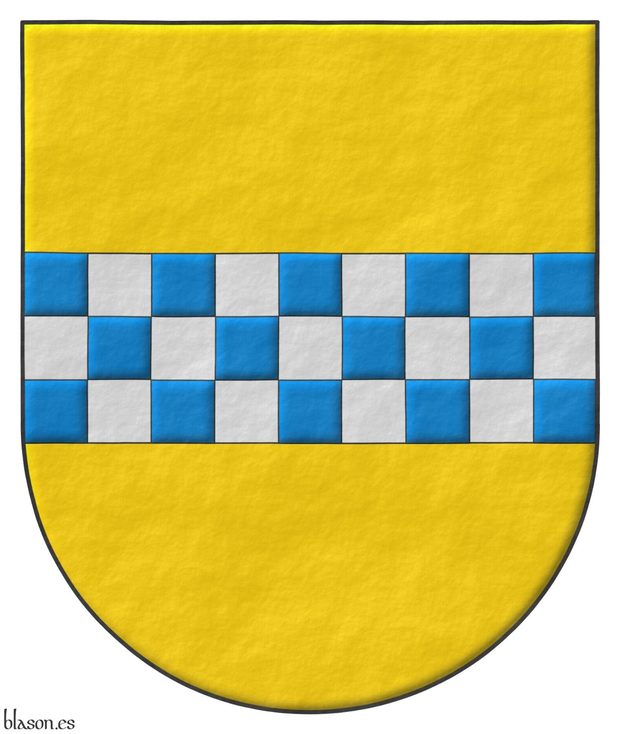
Or, a fess chequey Azure and Argent.
Escudo de oro, una faja ajedrezada de azur y plata.
Coat of arms emblazoned by me, illuminated with lights and shadows, outlined in Sable, with a semi-circular outer contour and with a rough finishing.
Coat of arms of the lineage Stewart of Scotland. I have emblazoned it with a fess chequy of 3 rows, symmetric and with 9 columns of squares, provided that its height is 1/3 of the width of the coat of arms.
Blazon keywords: Or, Azure, Argent, One, Three, Nine, Fess and Chequey.
Style keywords: Outlined in sable, Illuminated, Semi-circular and Rough.
Classification: Personal, Lineage, Interpreted, Boa and Coat of arms.
Bearer: Stewart of Scotland, lineage.


Talbot, lineage of England
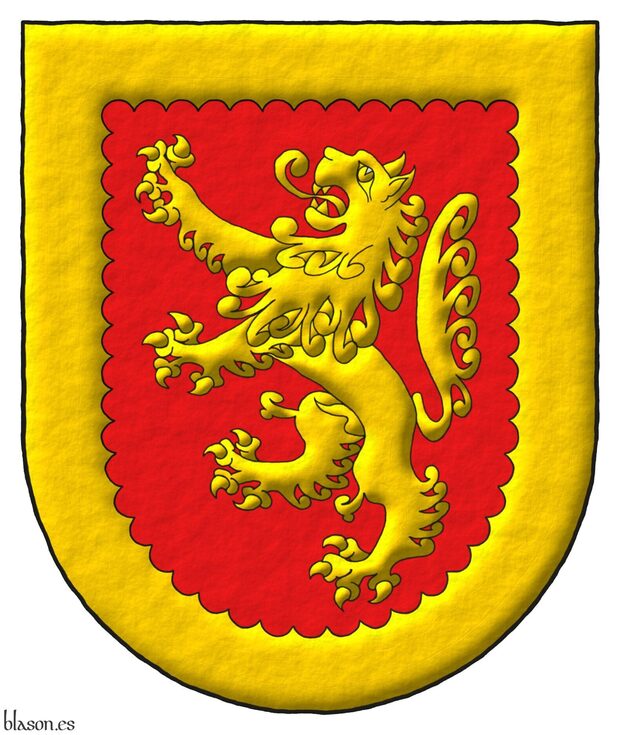
Blazon of the Talbot lineage of England.
Escudo de gules, un león rampante dentro de una bordura angrelada todo oro.
Gules, a lion rampant within a bordure engrailed Or.
Illuminated with lights and shadows and with a freehand finish.
[Rietstap, J. B.; 1861] writes it in French as «de gueules, au lion d'or, à la bordure engrelée du même». y [Burke, J.; 1836; volume 3, pages 359-360] writes it in English as «Gu. a lion rampant, within a bordure engr. or».
Blazon keywords: Without divisions, Gules, One, Lion, Rampant, Within, Bordure, Engrailed and Or.
Style keywords: Freehand, Outlined in sable, Illuminated and Semi-circular.
Classification: Interpreted, Lineage and Kingdom of England.


Uschiolo and Ustiolo, lineages
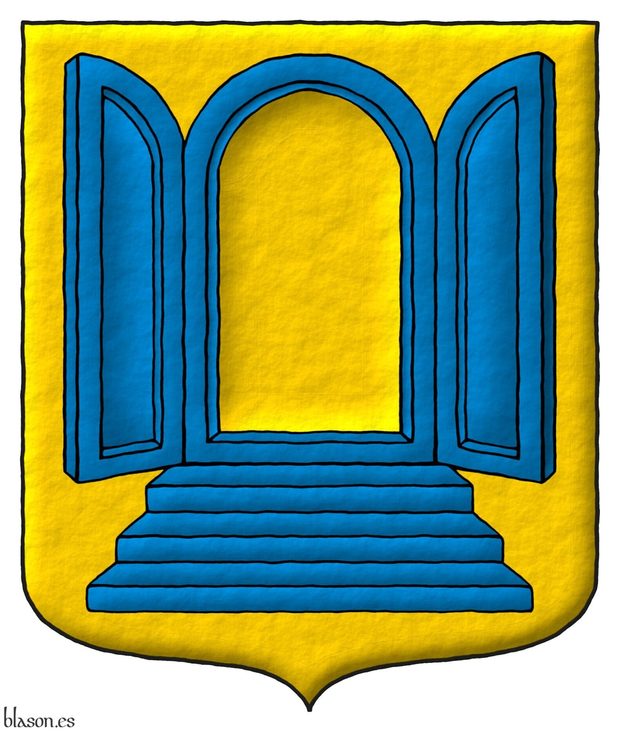
Or, a port Or, with jambs, enarched lintel, and two open leaves, upon a three-step stairway Azure.
Escudo de oro, una puerta con jambas, dintel arqueado, dos hojas abiertas sostenida de una escalinata de tres peldaños todo de azur, aclarada de oro.
Arms painted by me, highlighted with lights and shadows, outlined in Sable, with an ogee external shape and with a freehand finish.
Coat of arms of the lineages Uschiolo and Ustiolo, emblazoned by me following the blazon published by Vittorio Gifra in Italian: «Arma: d’oro, alla porta di due ante a timpano arcuato d’azzurro, scalinata di tre pezzi del medesimo e aperta del campo».
Blazon keywords: Or, Azure, One, Two, Three, Port, Arched, Enarched, Upon, Step, Stairway and Port and windows.
Style keywords: Outlined in sable, Illuminated, Ogee and Freehand.
Classification: Personal, Lineage, Interpreted, Boa and Coat of arms.
Bearer: Uschiolo and Ustiolo, lineages.


Vera, lineage of Aragon
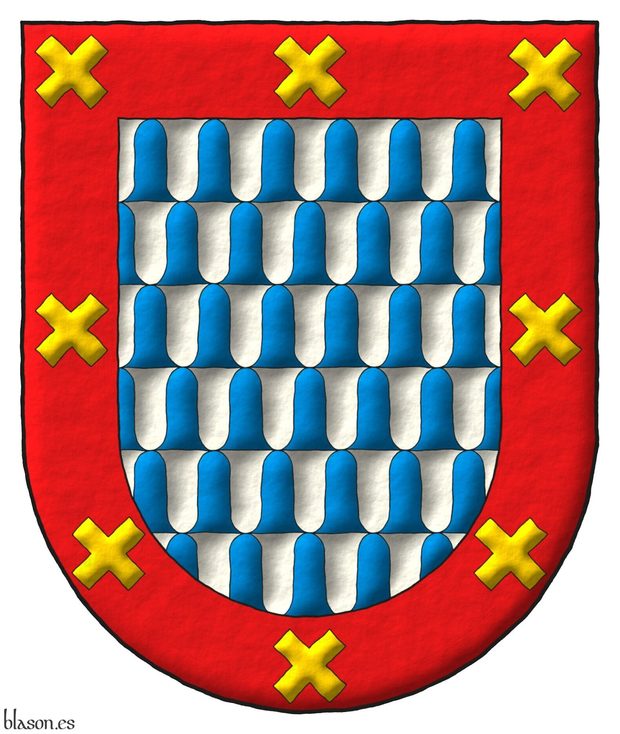
Blazon of the Vera lineage of Aragon.
Vair ancient, a bordure gules charged with eight saltires couped Or.
Escudo de veros antiguos, una bordura de Gules cargada de ocho sotueres cortados de oro.
Illuminated and with a glass finish.
It can be consulted in [Mogrovejo de la Cerda, J.; 1636; cover].
[Friar, S.; 1987; pages 156-157] says of the vair: «originates from the fur of a species of squirrel... which was popular in the Middle Ages as a lining for the garments of those not entitled to wear ermine. The animal was blue-grey on the back and white underneath. By sewing a number of these pelts together, with white and blue-grey alternating,... one which easily translated into the stylized armorial form of Vair and its variants».
Blazon keywords: Vair ancient, One, Bordure, Gules, Charged, Eight, Saltire, Party per fess and Or.
Style keywords: Freehand, Outlined in sable, Illuminated and Semi-circular.
Classification: Interpreted, Lineage and Coat of arms.


Vilardi, lineage of Italy
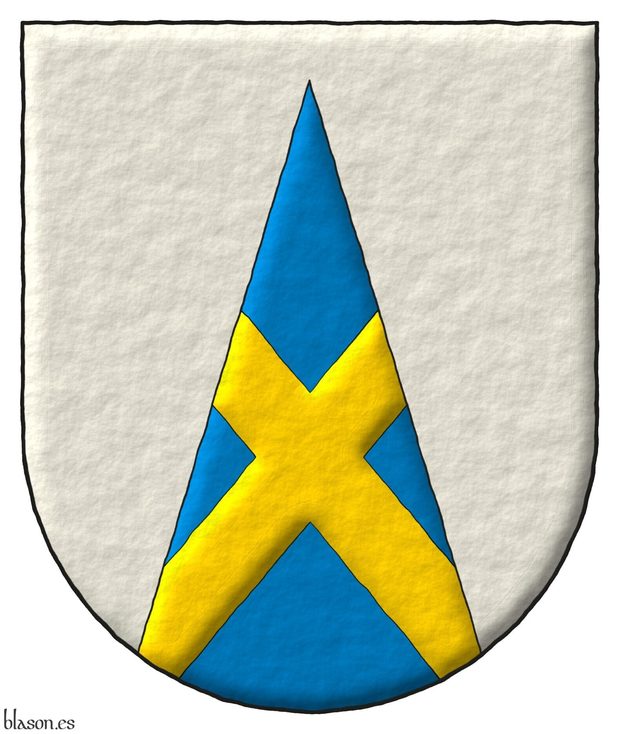
Blazon of the Vilardi lineage of Italy.
Argent, on a pile issuant from the base Azure a saltire Or.
Escudo de plata, una pira de azur cargada de un sotuer de oro.
Illuminated and a free hand finishing.
[Cadenas y Vicent, V. de; 2002; page 138] says that the a pile issuant from the base is «a triangle whose base issues from the base of the shield, being a third of its width», but when it is painted in [Cadenas y Vicent, V. de; 2002; page 268, figure 279] along with the pile the width of the base of both isosceles triangles is 2/3 of the width of the shield. I think the width of 2/3 is, in these 2 cases, better than 1/3 width, because with 1/3 there is not enough room for charges, as shown in the figure below.
There are scholars who say that the pile issuant from the base must not touch the upper edge of the shield and others that its tip should be in the center of the chief. In the previous image, the pile issuant from the base of the 1st shield fulfills the first affirmation, and in the 2nd shield, its tip is in the center of the chief.
I have the doubt if it should not be a saltire raguly.
Blazon keywords: Without divisions, Argent, One, Pile issuant from base, Azure, Charged, Saltire and Or.
Style keywords: Freehand, Outlined in sable, Illuminated and Semi-circular.
Classification: Interpreted, Lineage and Italian Republic.
-
Language
-
Categories of heraldry
-
Divisions of the field
- Without divisions
- Party per pale
- Party per fess
- Party per bend
- Party per bend sinister
- Tierce
- Tierce sinister
- Tierced per pale
- Tierced per fess
- Tierced per bend
- Tierced pallwise inverted
- Quarterly
- Quarterly per saltire
- Gyronny
- Party per fess, the chief per pale
- Party per pale, the sinister per fess
- Party per fess, the base per pale
- Party per pale, the dexter per fess
- Chapé
- Chaussé
- Embrassé
- Contre-embrassé
- Party per chevron
- Enté
- Enté en point
- Flanched
-
Metals
-
Colours
-
Furs
-
Other tinctures
-
Ordinaries and sub-ordinaries
-
Diminutives of the ordinaries
-
Geometric charges
-
Composite ordinaries
-
Inanimate charges from Nature
Atom, Crescent, Diamond, Emerald, Estoile, Increscent, Lightning flash, Moon, Mount, Mullet, Mullet of four points, Orbital, Plough of Ursa Major, Rainbow, Ray of the sun, River, Sea, Snowflake, Sun, Sun in splendour, Sun of May, Trimount, Water and Wave.
-
Vegetal charges from Nature
Acorn, Apple, Apple tree, Ash, Bluebonnet, Camellia, Chrysanthemum, Cinquefoil, Cornflower, Dogwood flower, Double rose, Elm, Fleur de lis, Flower, Gourd, Holm oak, Hop cone, Kapok tree, Laurel, Lily, Linden, Lotus flower, Madonna lily, Mexican cedar tree, Oak, Olive tree, Palm tree, Plantain plant, Pomegranate, Poplar leaf, Rose, Shamrock, Sunflower, Thistle, Tree, Tulip, Vine and Wheat.
-
Animal charges from Nature
Badger, Bald eagle, Barbel, Barn owl, Bear, Beaver, Beetle, Bighorn sheep, Blackbird, Boar, Brach hound, Bull, Doe, Dog, Dolphin, Dove, Eagle, Elephant, Falcon, Female figure, Fish, Flame, Fly, Fox, Frog, Goat, Goldfinch, Goose, Heron, Horse, Hummingbird, Jaguar, Lark, Leopard, Lion, Lion passant, Lion rampant guardant, Lioness, Lynx, Male figure, Martlet, Merino ram, Owl, Panther, Parrot, Peacock, Pelican, Pelican in her piety, Puffin, Quetzal, Raven, Roe deer, Rooster, Savage, Seagull, Serpent, She-wolf, Stag, Starling, Talbot, Tyger, Vulture, Warren hound and Wolf.
-
Parts of natural charges
Arm, Beak, Branch, Caboshed, Chest, Claw, Covert, Dorsal fin, Eagle claw, Ermine spot, Escallop, Feather, Foot (palmiped), Foreleg, Forepaw, Hand, Head, Heart, Hoof, Leaf, Neck, Ostrich feather, Palm frond, Paw, Roe deers' attires, Shoulder, Sprig, Stags' attires, Stem, Swallow-tail, Tail, Tail addorsed, Tail fin, Talon, Tooth, Trunk, Trunk (elephant), Two hands clasped, Two wings in vol, Udder, Wheat spike, Wing and Wrist.
-
Artificial charges
Ace of spades, Anchor, Anvil, Arch, Arm vambraced, Armillary sphere, Arrow, Axe, Bell, Bell tower, Beret, Bonfire, Book, Bookmark, Bow, Branding iron, Bridge, Broken, Buckle, Cannon, Cannon dismounted, Cannon port, Canopy roof, Carbuncle, Castle, Celtic Trinity knot, Chain, Chess rooks, Church, Clarion, Clay pot, Closed book, Club, Column, Comb, Compass rose, Conductor's baton, Cord, Covered cup, Crozier, Crucible, Cuffed, Cup, Cyclamor, Dagger, Double vajra, Drum, Ecclesiastical cap, Fanon, Federschwert, Fleam, Four crescents joined millsailwise, Galician granary, Garb, Gauntlet, Geometric solid, Grenade, Halberd, Hammer, Harp, Host, Hourglass, Key, Key ward, Knight, Knot, Lantern, Letter, Line, Loincloth, Menorah, Millrind, Millstone, Millwheel, Monstrance, Mortar, Mullet of six points pierced, Nail, Non-classic artifact, Norman ship, Number, Oar, Oil lamp, Open book, Page, Pair of scales, Parchment, Pestle, Piano, Pilgrim's staff, Plough share, Polish winged hussar, Port, Portcullis, Potent, Quill, Ribbon, Rosette of acanthus leaves, Sabre, Sackbut, Sail, Scroll, Scythe, Sheaf of tobacco, Ship, Skirt, Spear, Spear's head, Stairway, Star of David, Step, Sword, Symbol, Tetrahedron, Torch, Tower, Trident, Trumpet, Turret, Two-handed sword, Wagon-wheel, Water-bouget, Wheel, Winnowing fan and With a turret.
-
Immaterial charges
Angel, Archangel, Basilisk, Dragon, Dragon's head, Garuda, Golden fleece, Griffin, Heart enflamed, Justice, Mermaid, Our Lady of Mercy, Ouroboros, Paschal lamb, Pegasus, Phoenix, Sacred Heart of Jesus, Saint George, Sea-griffin, Trinity, Triton, Unicorn, Winged hand and Wyvern.
-
External elements
-
Heraldic creations
-
References
-
Formats
-
Keywords on this page
Port and windows, Horned, Watercolor, Chequey, Erased, Azure, Bibliography, Boa, Bordure, Head, Goat, Charged, Five, Ogee, De bibliotheca, Outlined in sable, Two, In black and white, Black and white with color plates, In chief, In pale, Coat of arms, Mullet, Fess, Fleur de lis, Personal, Gules, Illuminated, Interpreted, Castilian language, Lion, Lineage, Semi-circular, Nine, Eight, Or, Pale, Millstone, Argent, Without divisions, Kingdom of France, Sable, Six, Century XX, Vert, Upon, Freehand, Three and One.

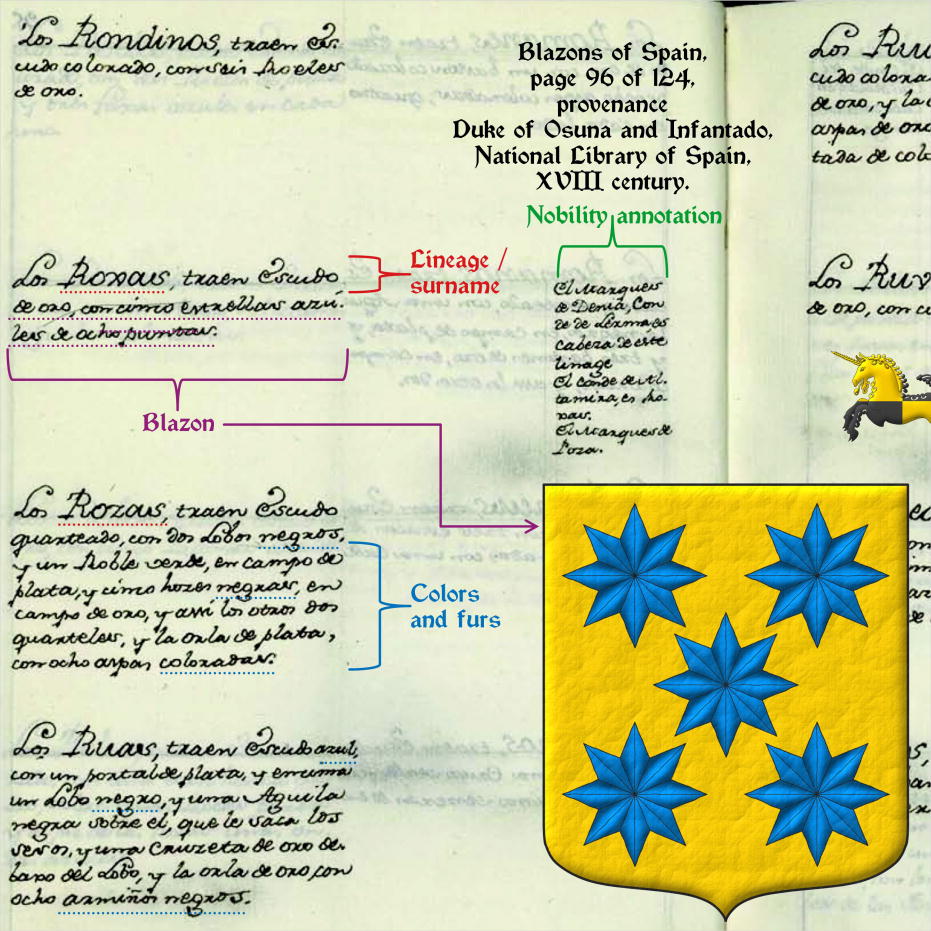
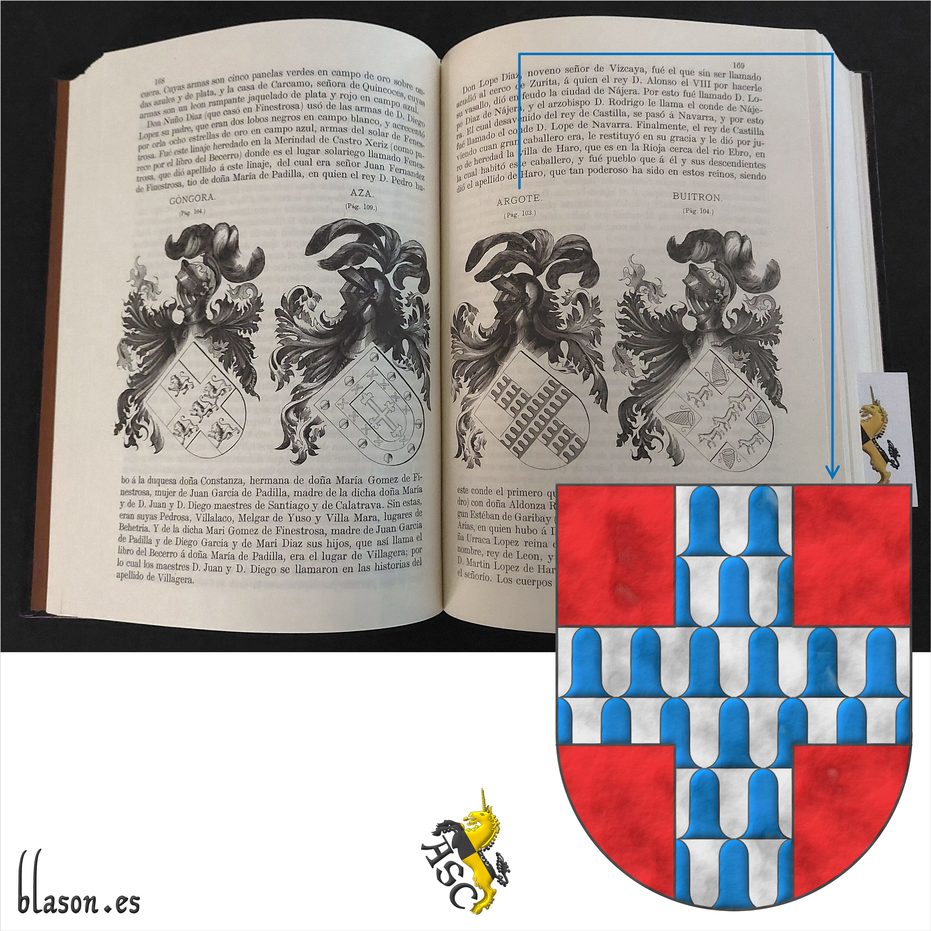
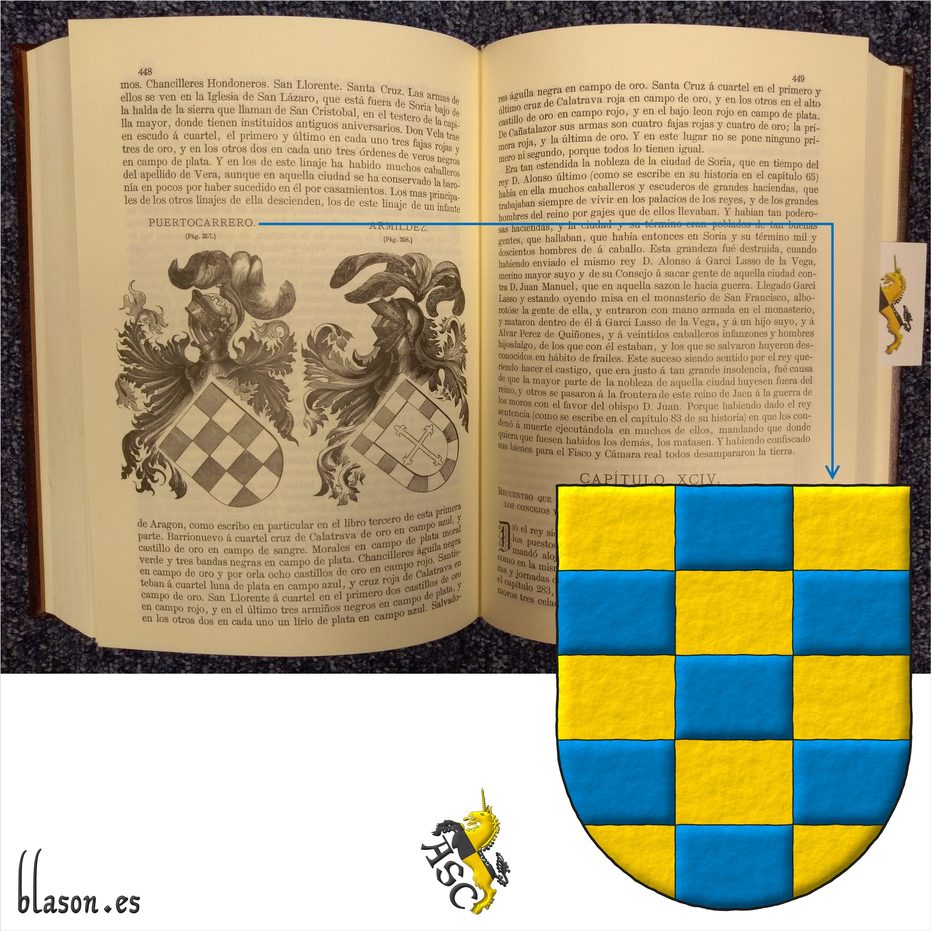
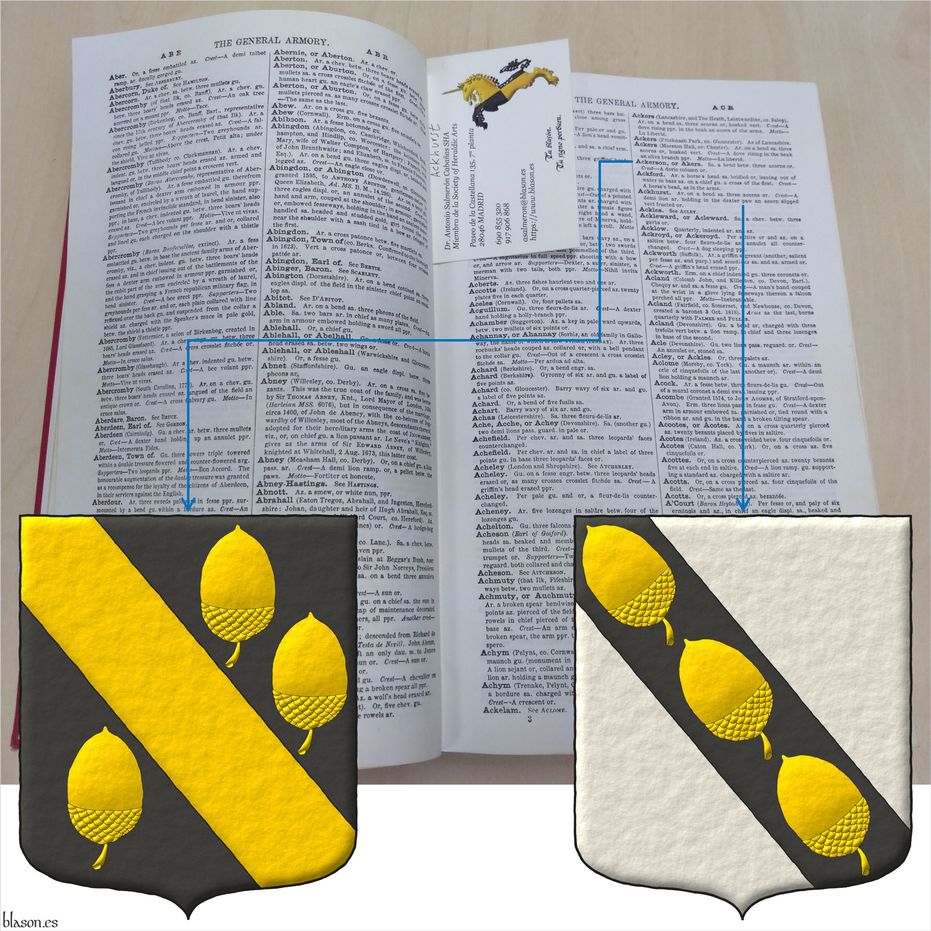
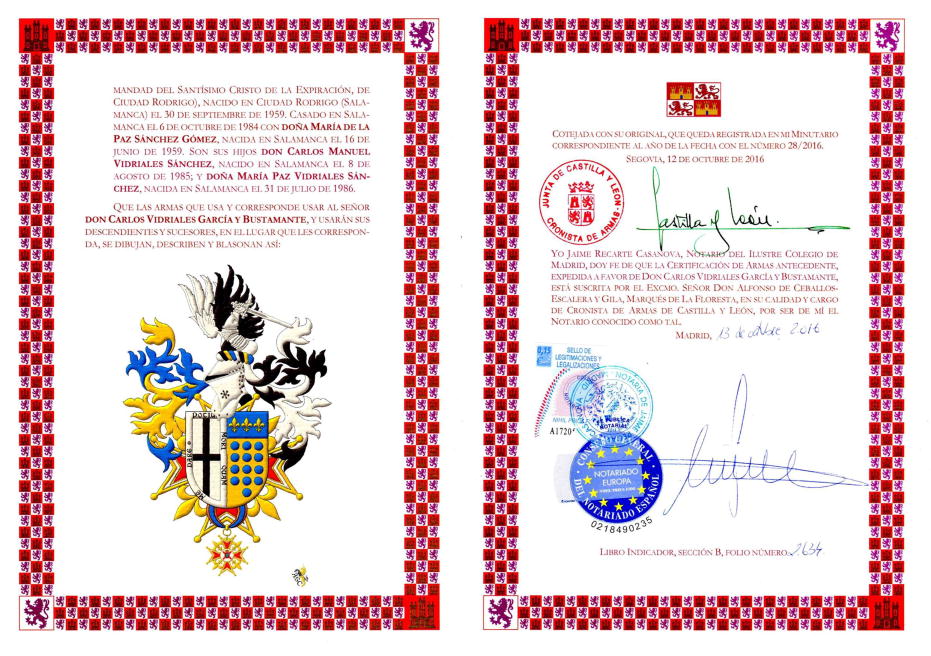
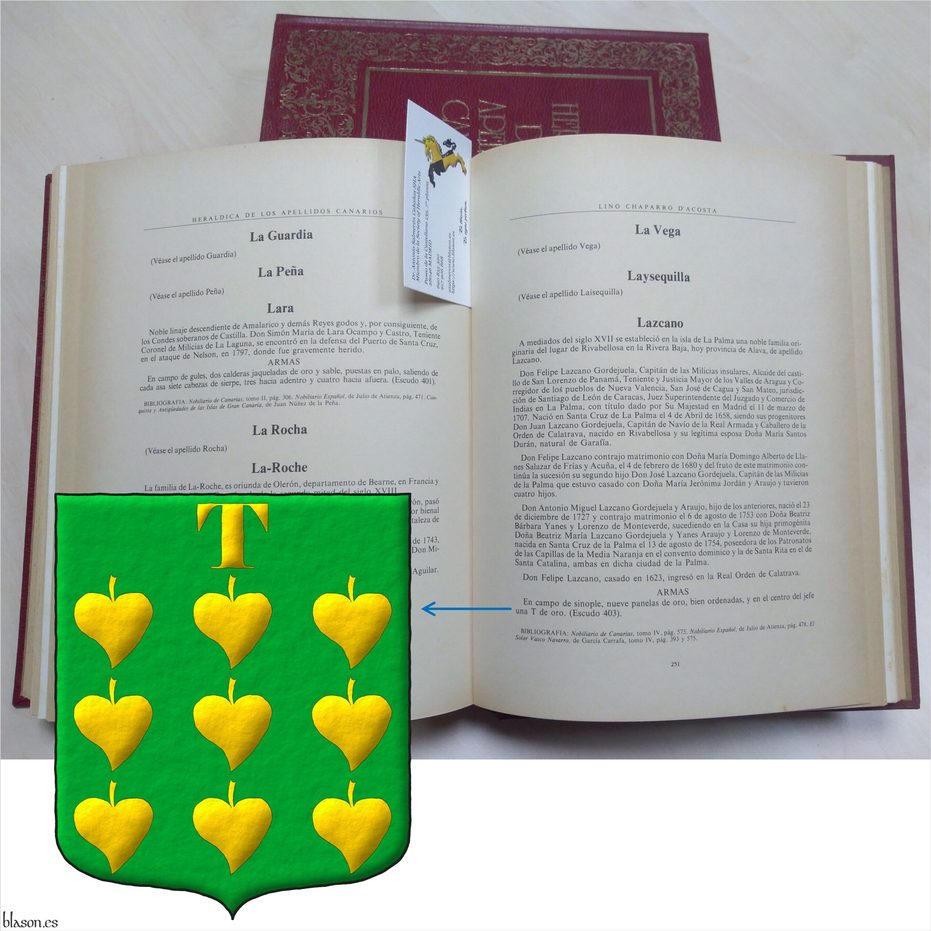
![Fernando Durán Cabral de Melo e Alpoim, scheme of 7 coats of arms Quarterly: 1 Gules, a pale Or upon six waves Azure and Argent, a bordure Or charged with eight lions' heads erased Gules [for Durán]; 2 Azure, a crescent reversed Argent, in dexter chief a fleur de lis Or, a bordure Gules [for Alpoim]; 3 Argent, two goats in pale Purpure, horned Sable [for Cabral]; 4 Gules, a double cross throughout Or cantoned by six plates, a bordure Or [for Melo]; an inescutcheon quarterly: 1 and 4 Argent, five escutcheons in cross Azure, each charged with five plates in saltire; a bordure Gules, charged with seven castles triple-towered Or, 3, 2, and 2 [for Portugal]; the whole debruised by a baston Sable; 2 and 3 party per chevron Argent and Gules, in chief two lions combatant Purpure, armed and langued Gules [for Leon], in base a castle triple-towered Or, port and windows Azure, masoned Sable [for Castile]; a bordure compony of eighteen sections Or and vair [for Álvarez de las Asturias].](../escudo_armas/DuranCabralMeloAlpoimNoronhaF.28.Esquema.4x3.jpg)
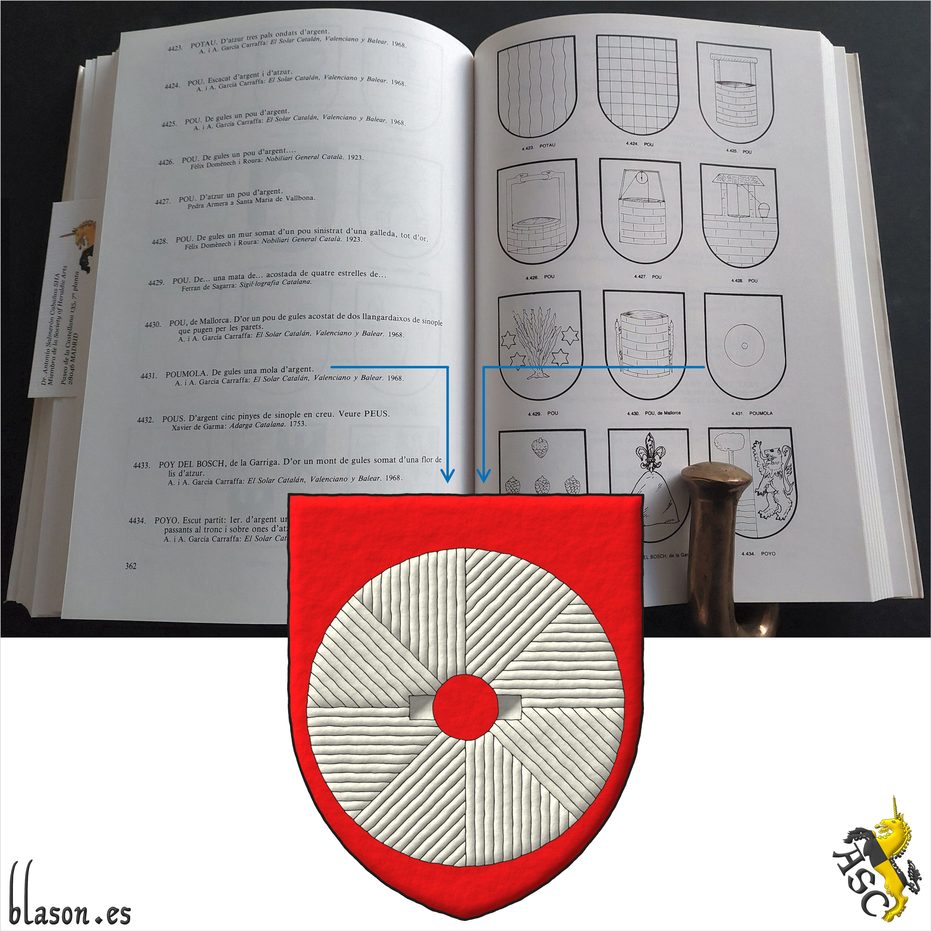
![Full achievement of the cadet branches of Fernando Durán Cabral de Melo e Alpoim Quarterly: 1 Gules, a pale Or upon six waves Azure and Argent, a bordure Or charged with eight lions' heads erased Gules [for Durán]; 2 Azure, a crescent reversed Argent, in dexter chief a fleur de lis Or, a bordure Gules [for Alpoim]; 3 Argent, two goats in pale Purpure, horned Sable [for Cabral]; 4 Gules, a double cross throughout Or cantoned by six plates, a bordure Or [for Melo]; an inescutcheon Azure, five fleurs de lis Or. Crest: Upon a helm in profile Argent, with visor bars Or, and a wreath Or and Azure, an arm proper, vested Azure, lined Or, supporting a scroll Azure doubled Or, inscribed with the cry «Notre Dame du Puy» Or. Mantling: Azure doubled Or.](../escudo_armas/DuranCabralMeloAlpoimF.23.ArmeriasCompletas.5Lises.TrazoAlzado.jpg)
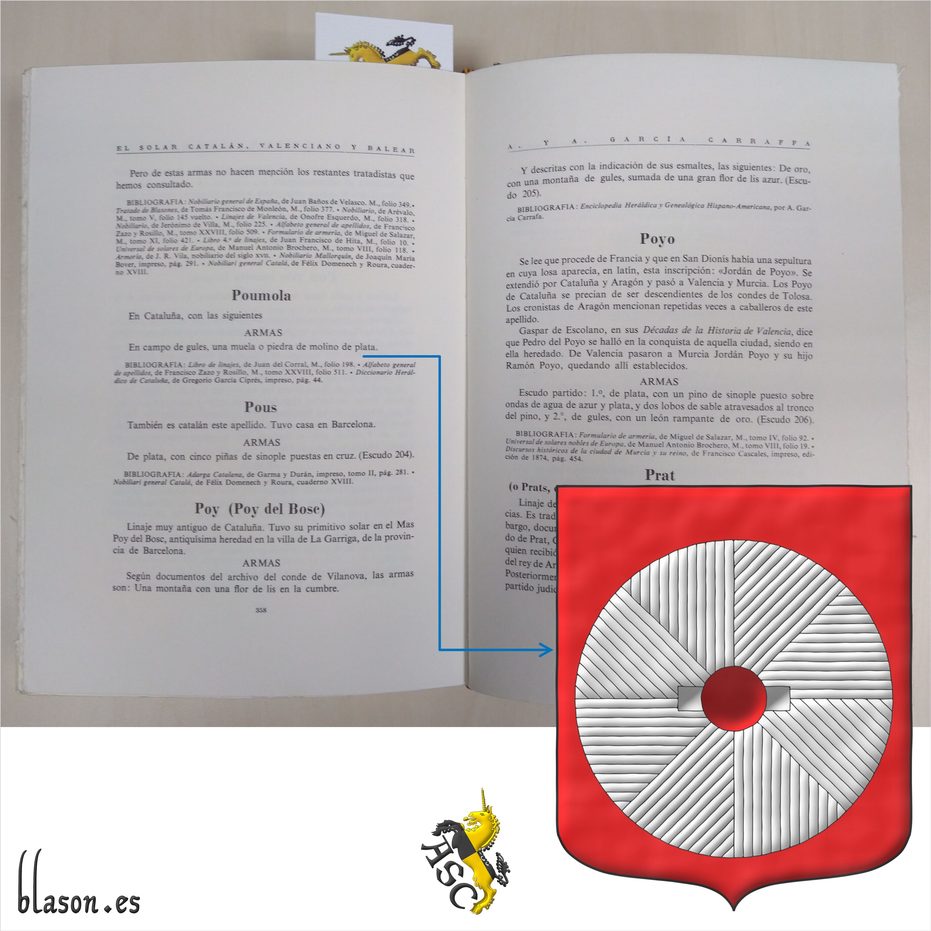
![Ignasi Pujol, comparation [ Azure, a mount issuant from the base, in chief a fleur the lis Argent ] and [ Party per chevron Azure and Or, in chief a fleur de lis Argent, in base four pallets Gules ].](../escudo_armas/PujolIgnasi.20.PujolLineage.Ogee.Compare.jpg)
